Daisies are one of the best flowers to grow as a newer gardener, with most varieties being extraordinarily hardy and drought-tolerant. However, with 20,000 species of the daisy family that vary in color, size, and care, how do you choose the best variety for your garden?
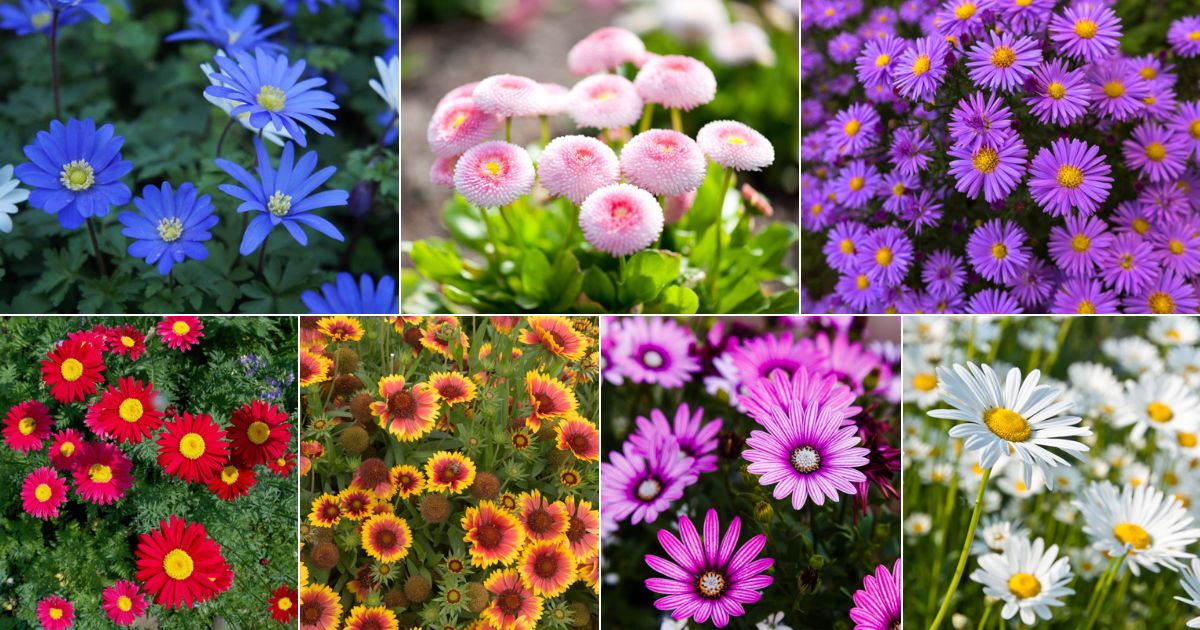
Here are the most popular daisy varieties anyone can grow.
Jump to:
- African Daisy
- Aster
- ‘Becky’ Shasta Daisy
- Blue-Eyed Beauty
- Butter Daisy
- Cape Marguerite Daisy
- Chocolate Daisy
- Coneflower Daisy
- Crown Daisy
- Dahlberg Daisy
- Damianita Daisy
- Desert Star
- Engelmann's Daisy
- English Daisy
- Felicia Daisy
- Flame African Daisy
- Florist's Daisy
- Gaillardia Daisy
- Gerbera Daisy
- Gloriosa Daisy
- Golden Marguerite
- Indian Chrysanthemum Daisy
- Livingstone Daisy
- Marguerite Daisy
- Nippon Daisy
- Oxeye Daisy
- Painted Daisy
- PowWow® Wild Berry Coneflower Daisy
- Pure White Butterfly® Marguerite
- Revolution™ Bicolor Red Lemon Gerbera Daisy
- Shasta Daisy
- Silver Townsendia Daisy
- ‘Sombrero Adobe Orange’ Coneflower Daisy
- Swan River Daisy
- Wine African Daisy
- Frequently Asked Questions
African Daisy
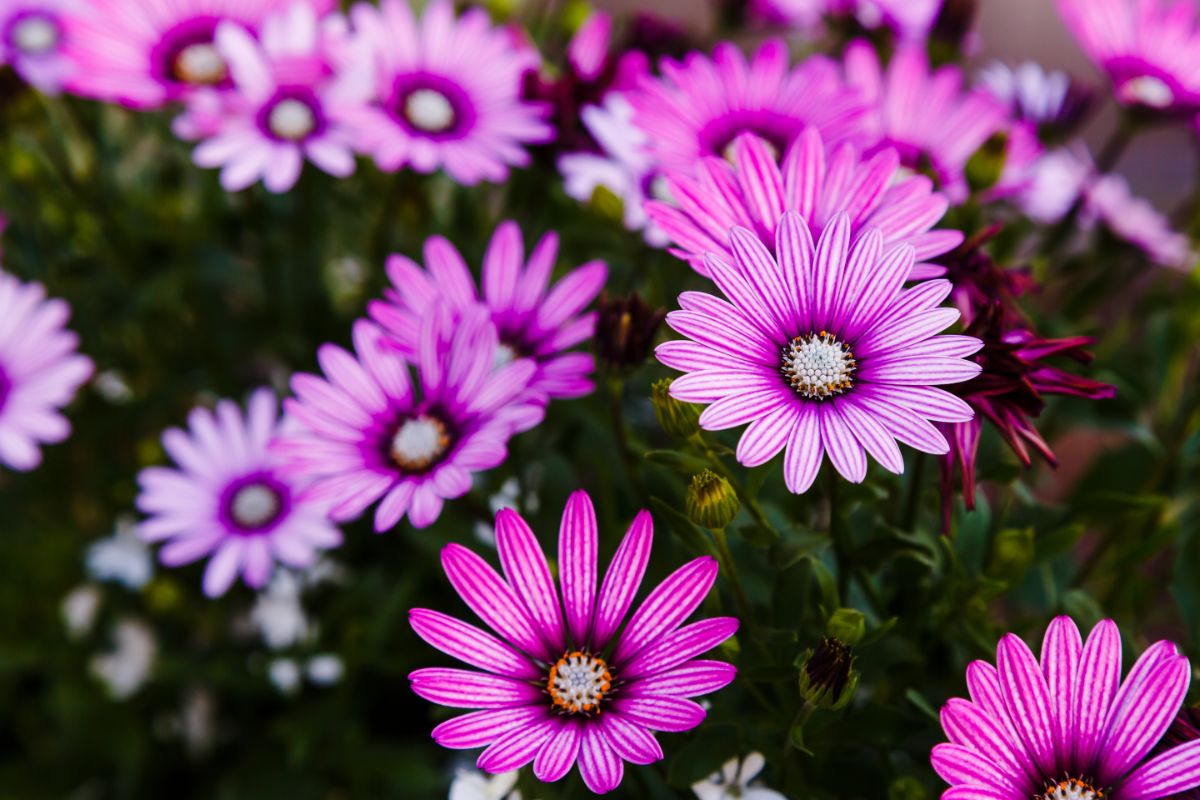
| Scientific name: | Osteospermum spp. |
| Plant Type: | Perennial |
| Sun Exposure: | Full sun |
| Watering Needs: | Regular watering, avoid overwatering |
| Soil Type: | Moist, Well-Drained |
| Hardiness Zone: | 10-11 (USDA) |
Osteospermum spp., or African daisies, resemble the common daisy with its long petals surrounding its round disk. Its gorgeous white, yellow, red, purple, blue, or multicolored petals may be flat or have a curved appearance.
Plant African daisies in the spring and enjoy their fast growth rate. They are practically effortless to grow as long as they get plenty of sunlight and moist, well-drained soil.
Aster
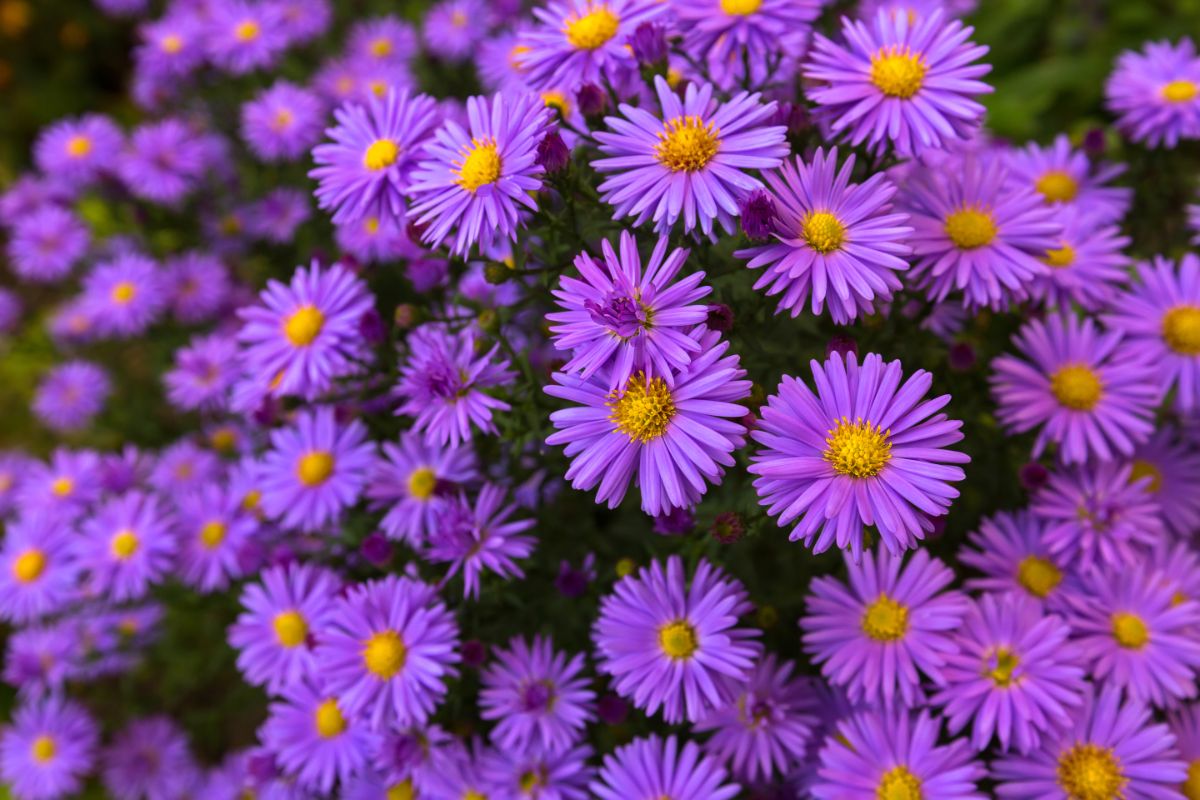
| Scientific name: | Symphyotrichum |
| Plant Type: | Herbaceous, perennial |
| Sun Exposure: | Full sun |
| Watering Needs | Regular watering, avoid overwatering |
| Soil Type: | Loamy, well-drained |
| Hardiness Zone: | 3-8 (USDA) |
Asters are a popular variety in the daisy family, Asteraceae, that offer stunning pink, blue, white, or purple blooms from August into fall.
Though you can typically find these perennials pop up in stores during the fall season, they can stick around for years to come. Although aster requires weekly watering, be sure not to overwater as it could cause root rot.
‘Becky’ Shasta Daisy
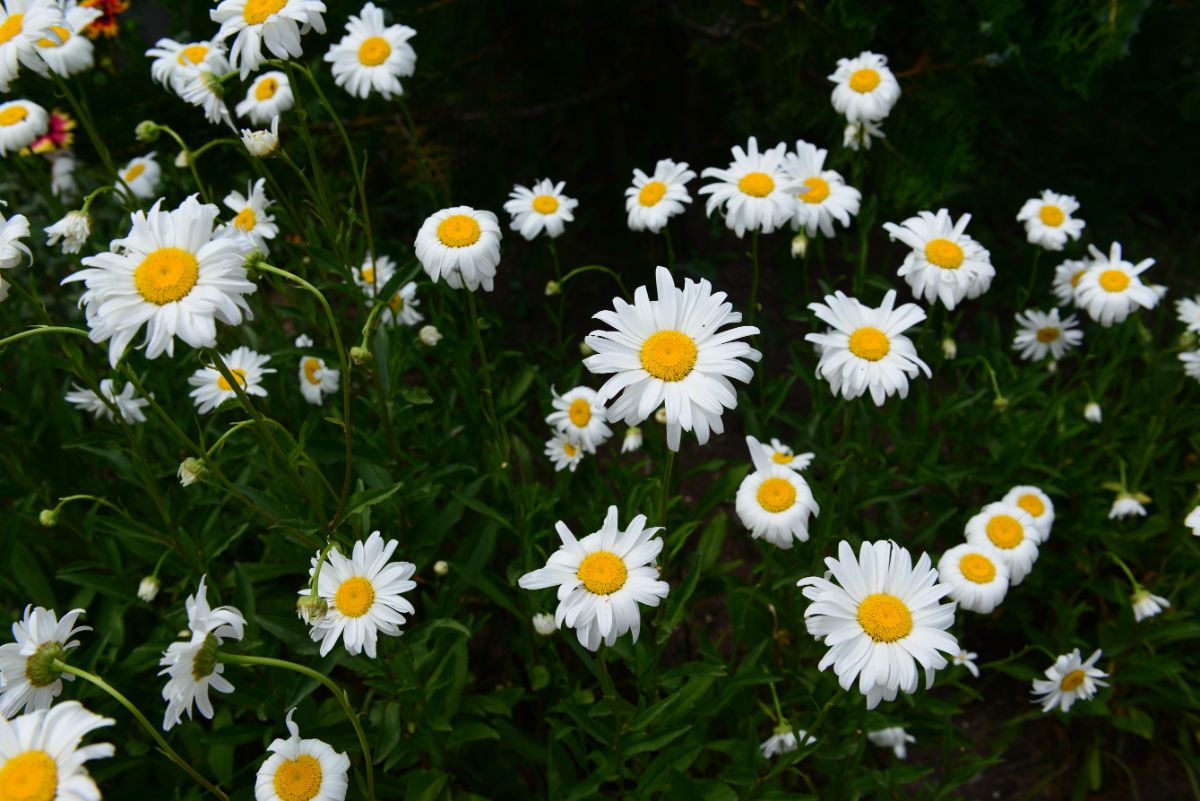
| Scientific name: | Leucanthemum x superbum ‘Becky’ |
| Plant Type: | Perennial |
| Sun Exposure: | Full sun |
| Watering Needs: | Regular watering, avoid overwatering |
| Soil Type: | Well-drained |
| Hardiness Zone: | 4-9 (USDA) |
‘Becky’ Shasta Daisy is one of the most popular of the Shasta daisy varieties. Its large three- to four-inch flowers grow on sturdy stems that may reach up to three feet tall. These bright white flowers with yellow disks were named Perennial Plant of the Year in 2003.
Not only do they grow quickly, but they have a habit of aggressively spreading along with your garden. With full sun, weekly watering, and moist but well-drained soil, they are low-maintenance plants anyone can grow.
Blue-Eyed Beauty
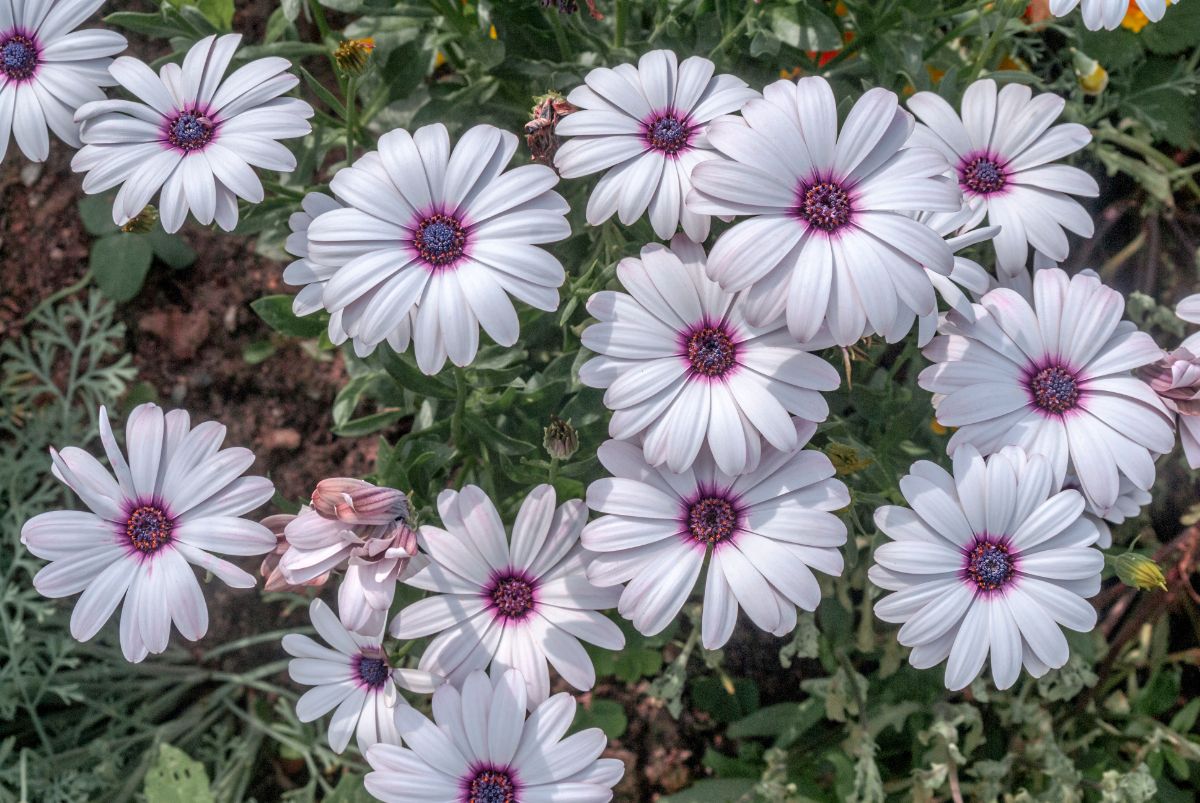
| Scientific name: | Osteospermum ecklonis 'Blue-Eyed Beauty' |
| Plant Type: | Perennial in zones 9-10, Annual otherwise |
| Sun Exposure: | Full sun to part shade |
| Watering Needs: | Regular watering, avoid overwatering |
| Soil Type: | Moist, Well-Drained |
| Hardiness Zone: | 4-9 (USDA) |
The Blue-Eyed Beauty is a showy cultivar of the African Daisy that is easy to spot out of a crowd of daisies. Its vibrant yellow petals contrast with its blueish-purple center is sure to brighten up your garden.
This easy-to-grow plant can adapt to various growing conditions and is drought tolerant, though it enjoys moist soil. For a unique daisy that requires little maintenance, you can’t go wrong with the Blue-Eyed Beauty.
Butter Daisy

| Scientific name: | Melampodium divaricatum |
| Plant Type: | Annual |
| Sun Exposure: | Full sun |
| Watering Needs: | Regular watering, avoid overwatering |
| Soil Type: | Well-Drained |
| Hardiness Zone: | 6-9 (USDA) |
The Butter Daisy is one of the easiest flowers to grow from seed, and you can enjoy their tiny one-inch yellow blooms all season long.
These self-seeding plants will keep coming back so long as they are in a sunny location and receive regular drinks of water. Not only are they easy to grow, but they repel insects and are deer-resistant.
Cape Marguerite Daisy
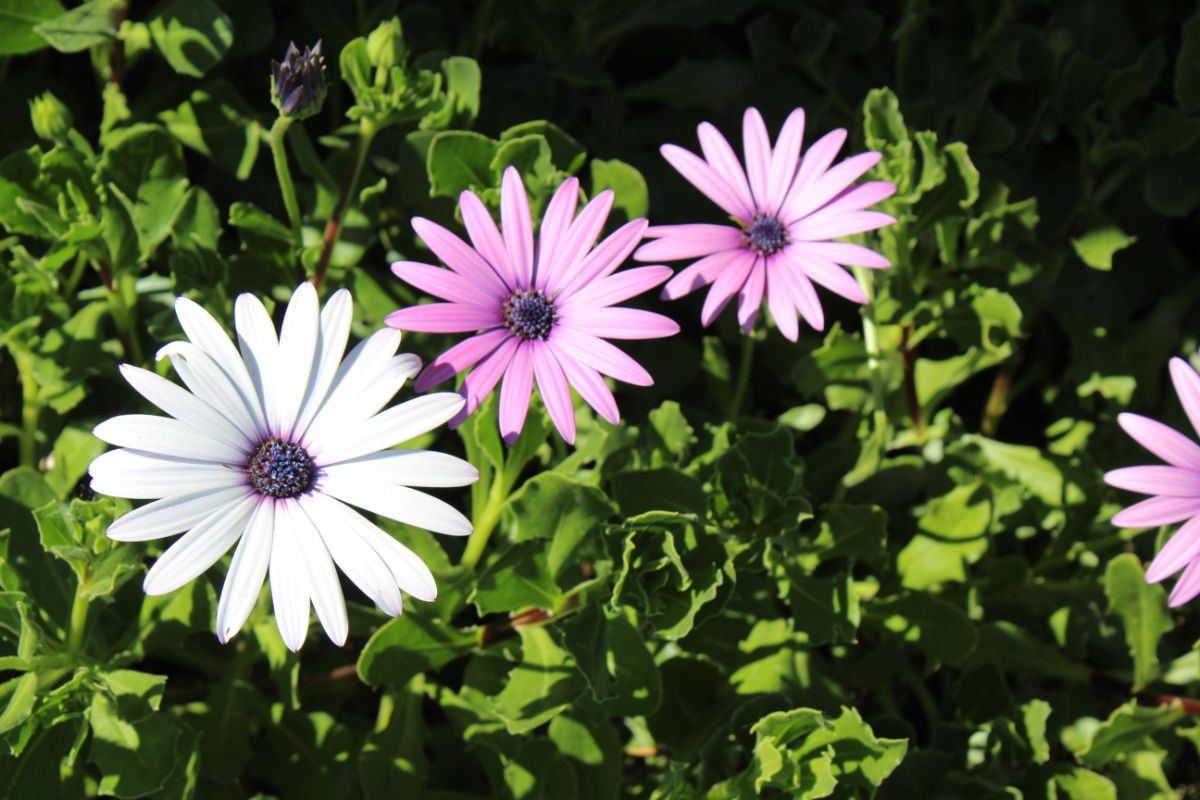
| Scientific name: | Dimorphotheca ecklonis |
| Plant Type: | Perennial |
| Sun Exposure: | Full sun |
| Watering Needs: | Light Watering |
| Soil Type: | Well-Drained, fertile soil |
| Hardiness Zone: | 9-11 |
Dimorphotheca ecklonis may also be referred to as Cape Marguerite Daisy, Van Stadens river daisy, Sundays River Daisy, Blue-and-White Daisy Bush, or White Daisy Bush. Their showy pink or white flowers are sure to add a burst of color to your garden.
You can enjoy their large blooms, up to four inches across, all summer and fall long. Once established, they don’t need much watering unless they go through periods of drought or extreme heat.
Chocolate Daisy
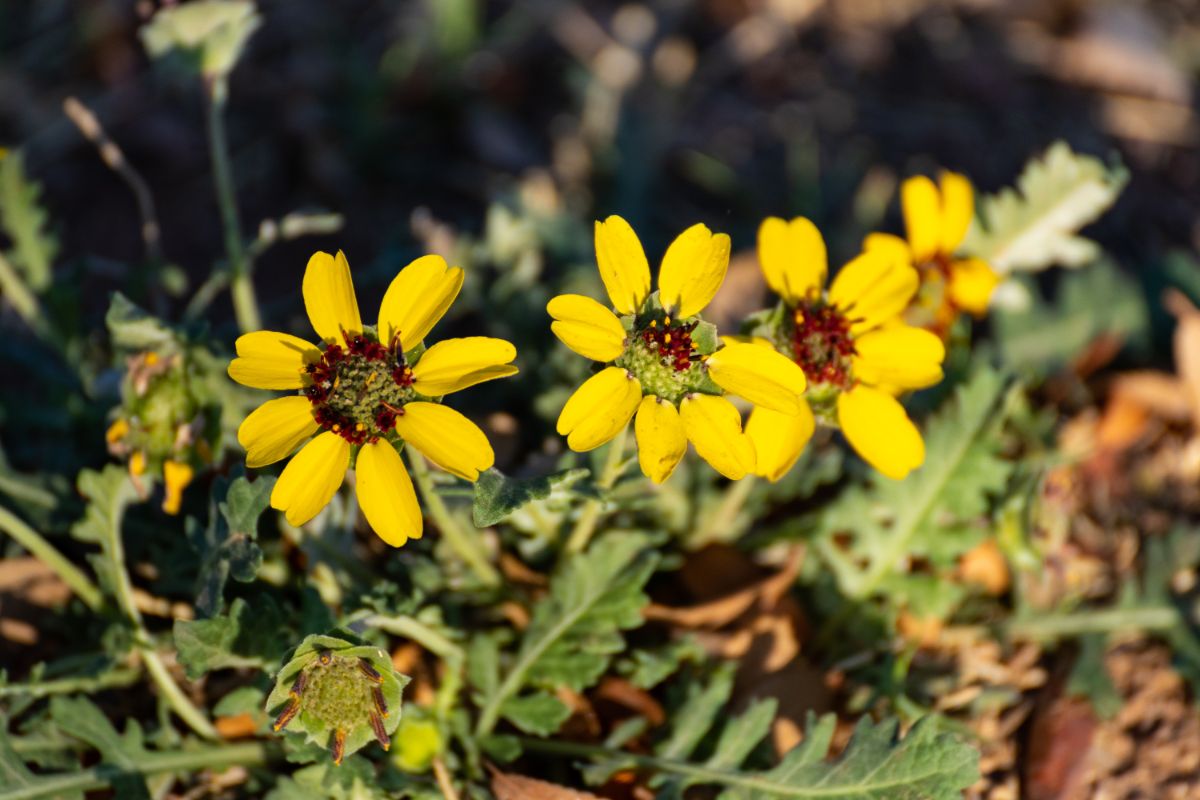
| Scientific name: | Berlandiera lyrata |
| Plant Type: | Perennial |
| Sun Exposure: | Full sun |
| Watering Needs: | Light watering |
| Soil Type: | Well-drained rocky or sandy soil |
| Hardiness Zone: | 4-10 (USDA) |
While the Chocolate Daisy may look like a standard yellow daisy, it has an incredible cocoa scent. Additionally, you can use these herbs as a garnish for a colorful dark chocolate flavor.
This drought-tolerant plant doesn't require a whole lot of watering once it's established, though it enjoys a drink during a dry spell. Don't be worried if they look a little limp during a hot afternoon; they'll perk up by morning.
Coneflower Daisy
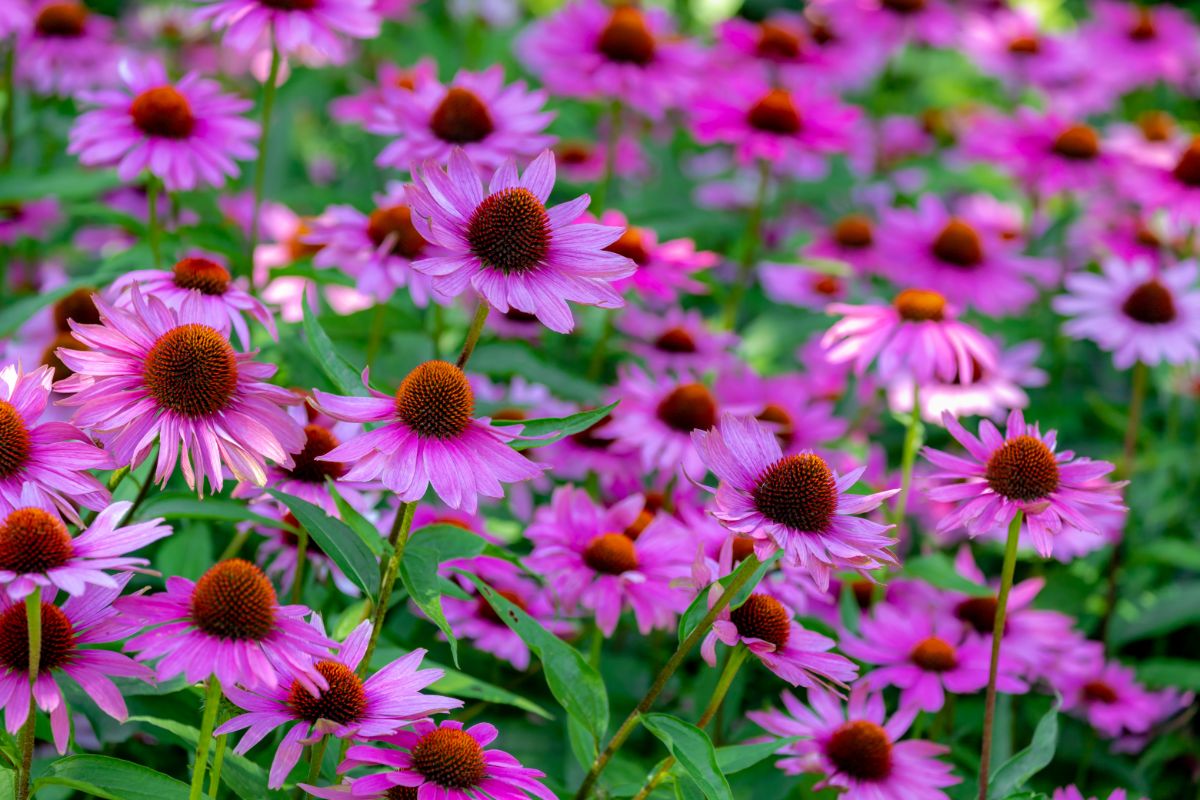
| Scientific name: | Echinacea |
| Plant Type: | Perennial |
| Sun Exposure: | Full sun, partial shade |
| Watering Needs: | Regular watering, avoid overwatering |
| Soil Type: | Neutral to acidic well-drained soil |
| Hardiness Zone: | 3-8 (USDA) |
Coneflowers are incredibly hardy and can withstand periods of drought, making them a top choice for newer gardeners who may miss a few waterings. They're long-blooming and come in a range of colors, including pink, red, orange, white, and yellow.
Plant these beauties after the last frost in spring, and they will germinate in about four weeks. With its fibrous root system, it adapts well to various garden conditions and handles dividing and transplanting well.
Crown Daisy
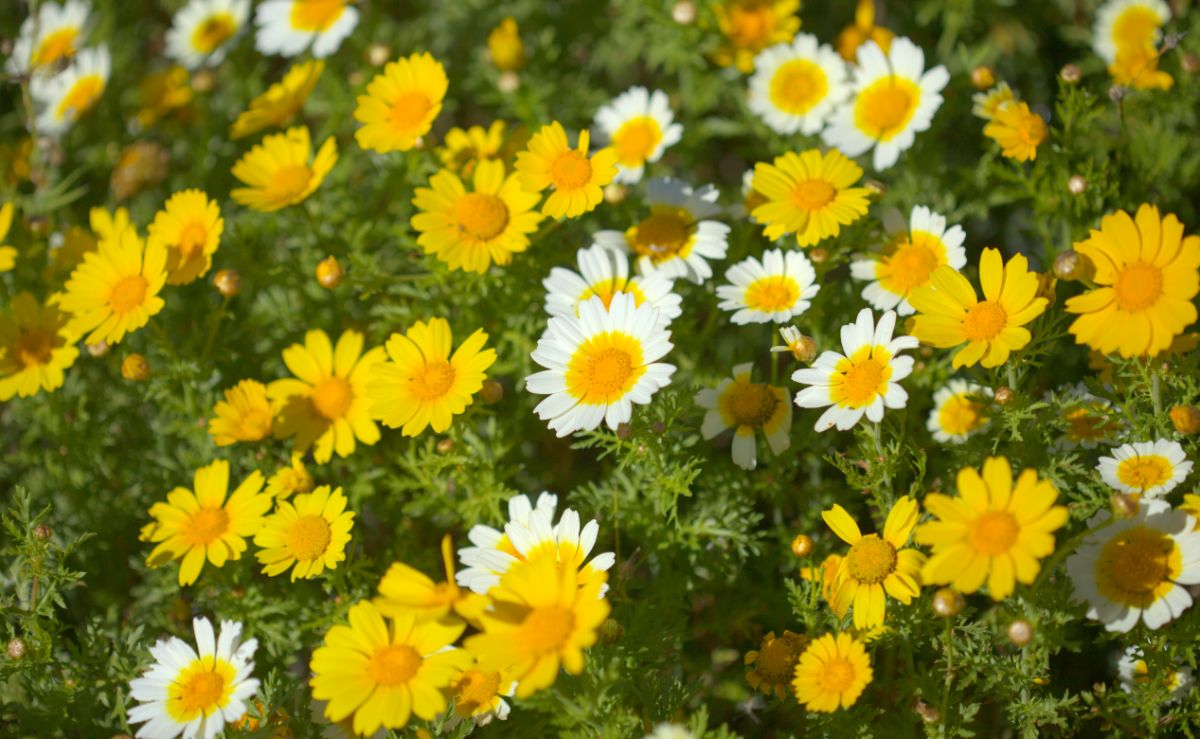
| Scientific name: | Glebionis coronaria |
| Plant Type: | Annual vegetable |
| Sun Exposure: | Full sun to partial shade |
| Watering Needs: | Regular watering as seedlings, only during droughts at maturity |
| Soil Type: | Well-drained |
| Hardiness Zone: | 5-9 (USDA) |
Crown Daisy is a famous annual grown for its peppery leaves, especially in Asia. Crown daisies are easy to grow, but ensure that they are not overcrowded and become invasive.
If growing for their flavor, spring or fall planting is best. As seedlings, they’ll need plenty of water but only require watering during seasons of drought once they’re established.
Dahlberg Daisy
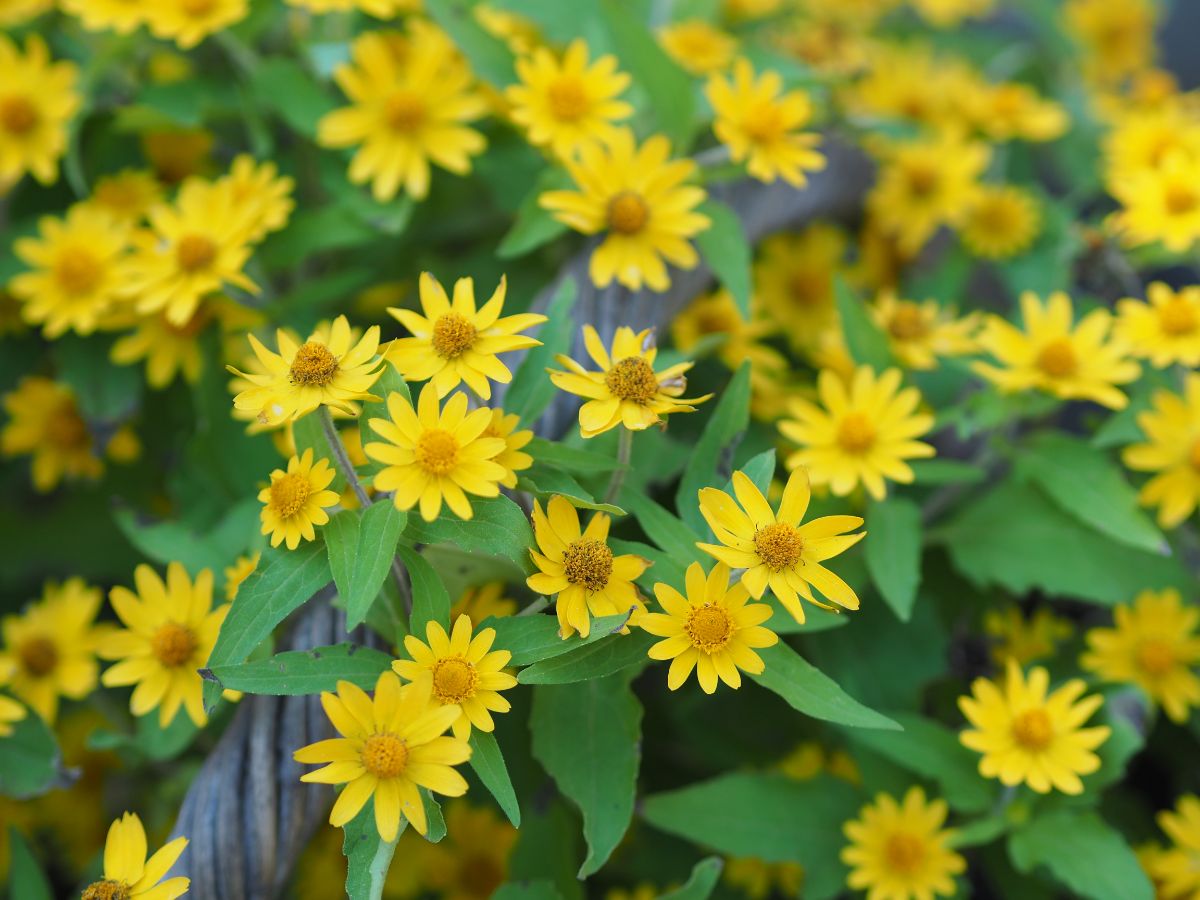
| Scientific name: | Thymophylla tenuiloba |
| Plant Type: | Annual |
| Sun Exposure: | Full sun |
| Watering Needs: | Infrequent watering |
| Soil Type: | Well-drained sandy soil |
| Hardiness Zone: | 5-11 (USDA) |
Dahlberg Daisy, also known as Golden Fleece Shooting Star, or Bristleleaf Pricklyleaf, this bushy flowering annual plant will add a lemon-scent aroma to your garden.
Its fragrant leaves are very fine and have multiple branches that bloom dainty yellow daisies. These daisies require minimal care, only requiring water every once in a while.
Damianita Daisy
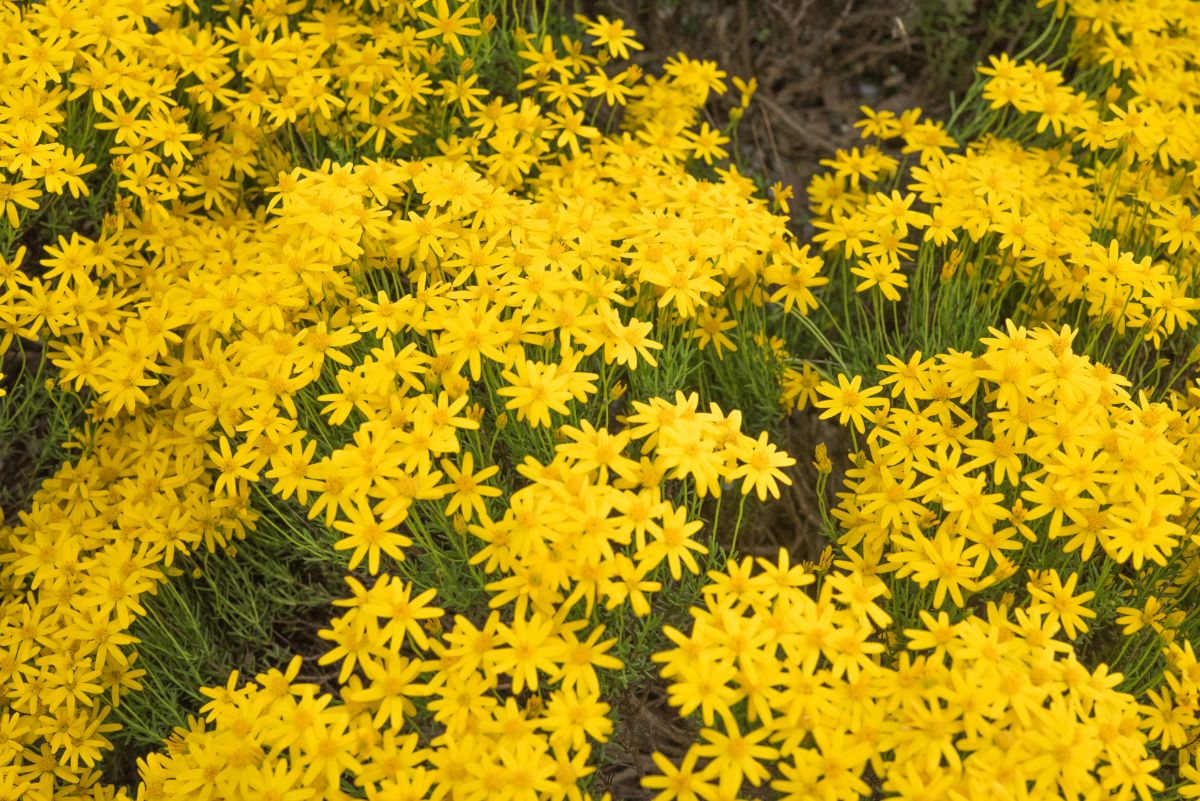
| Scientific name: | Chrysactinia mexicana |
| Plant Type: | Perennial |
| Sun Exposure: | Full sun |
| Watering Needs: | Light watering |
| Soil Type: | Well-drained |
| Hardiness Zone: | 8-10 (USDA) |
The Chrysactinia mexicana, more commonly known as the Damianta Daisy, is famous for its low maintenance and ability to thrive in various conditions. The Damianta Daisy features thin green leaves, vibrant lemon-yellow flowers, and a fragrance that attracts pollinators.
They have a slower growth rate when compared to other varieties and may take a few years to flower when grown from seed. Damianta Daisies only need infrequent watering, plenty of sunlight, and well-drained soil to thrive in your garden.
Desert Star
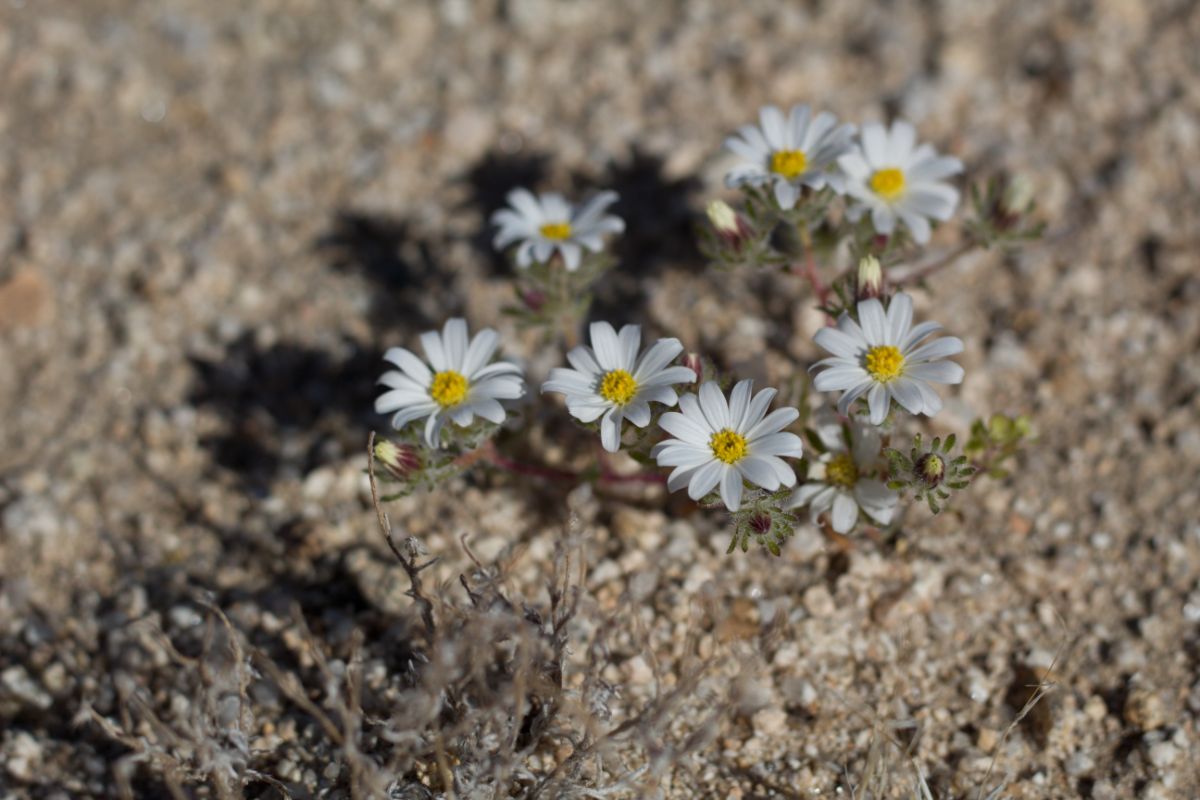
| Scientific name: | Monoptilon bellidiforme |
| Plant Type: | Annual herb |
| Sun Exposure: | Full sun |
| Watering Needs: | Infrequent watering |
| Soil Type: | Sandy |
| Hardiness Zone: | 4-9 (USDA) |
Desert Star, also called the Daisy Desertstar, is an annual herb that naturally grows in southwestern deserts within the United States. Its stems are very short, no more than a few centimeters long. Its tiny flowers are typically white but may have a purple tint to them.
These unique daisies thrive in soil similar to their native sandy habitat but can do okay in others.
Engelmann's Daisy

| Scientific name: | Engelmannia pinnatifida |
| Plant Type: | Perennial |
| Sun Exposure: | Partial shade to full sun |
| Watering Needs: | Light to regular watering |
| Soil Type: | Sandy loams to clay loams |
| Hardiness Zone: | 4-8 (USDA) |
Engelmann's Daisy gets its name from George Engelmann, a German physician and botanist in the 1800s who would eventually settle down in St. Louis, Missouri.
This perennial has stems that reach up to two feet tall and bloom in bright yellow flower clusters. It may appear as if they have wilted in the hot sun but will open up by the following morning. This daisy variety loves a good amount of sun and sandy loams to clay loams (avoid any heavy clays).
English Daisy

| Scientific name: | Bellis perennis |
| Plant Type: | Biennial |
| Sun Exposure: | Partial sun |
| Watering Needs: | Regular watering (not drought-tolerant) |
| Soil Type: | Loamy, moist |
| Hardiness Zone: | 4-8 (USDA) |
English daisies are a biennial plant, meaning they germinate and produce foliage the first year, then bloom in the spring. For an instant addition to color in your garden, purchase plants that have already bloomed.
These self-seeding plants spread quickly, allowing you to enjoy future blooms for years to come. They do well with other plants that flower in colder spring weather, such as pansies or violets. Container gardening can help prevent their spread, causing them to be less invasive.
Felicia Daisy
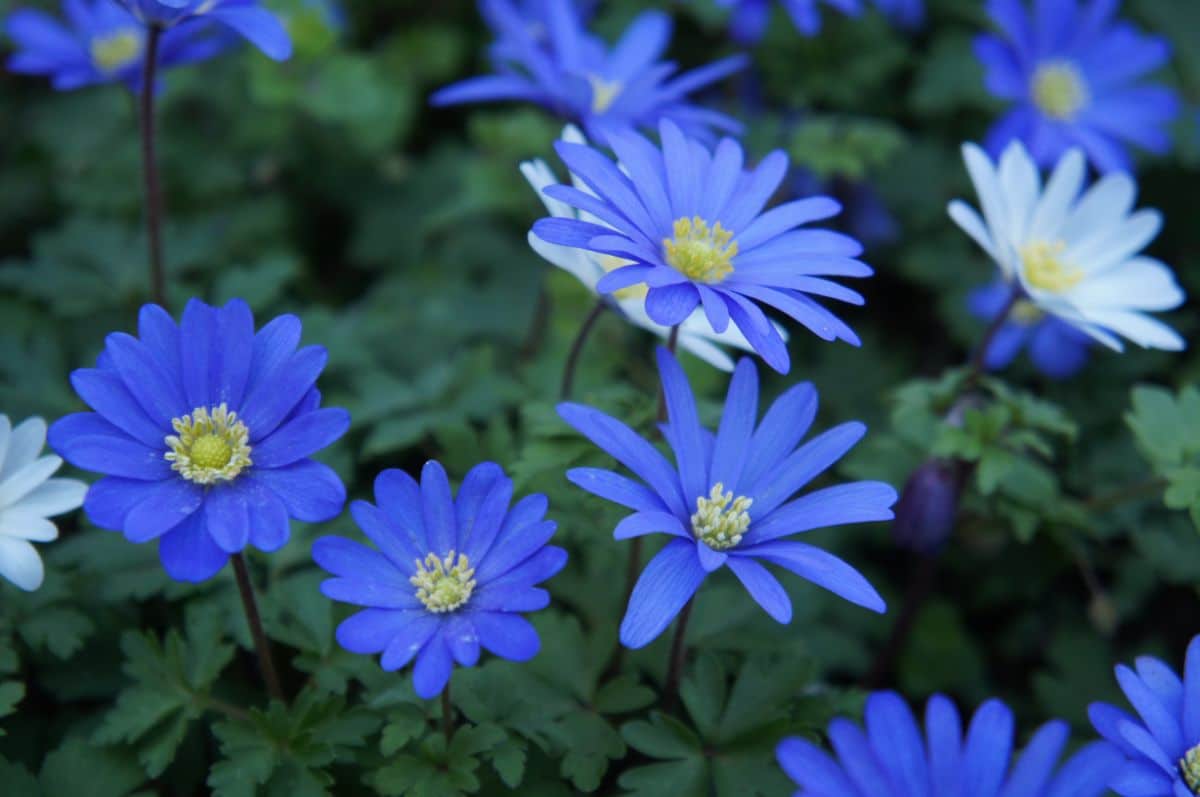
| Scientific name: | Felicia amelloides |
| Plant Type: | Perennial |
| Sun Exposure: | Full sun |
| Watering Needs: | Regular watering, avoid overwatering |
| Soil Type: | Moist, Well-Drained |
| Hardiness Zone: | 8-11 (USDA) |
The Felicia Daisy, also known as Blue Marguerite, Blue Daisy, or Blue Kingfisher Daisy, is a bright bushy flowering perennial that produces showy blue blooms with bright yellow central eyes. Its beautiful blue blooms attract butterflies and other pollinators.
This low-maintenance plant thrives in hot, dry climates and doesn't like overly watered soil or a humid environment. It is important to note that Felicia Daisy can be aggressive and may choke out weaker plants.
Flame African Daisy
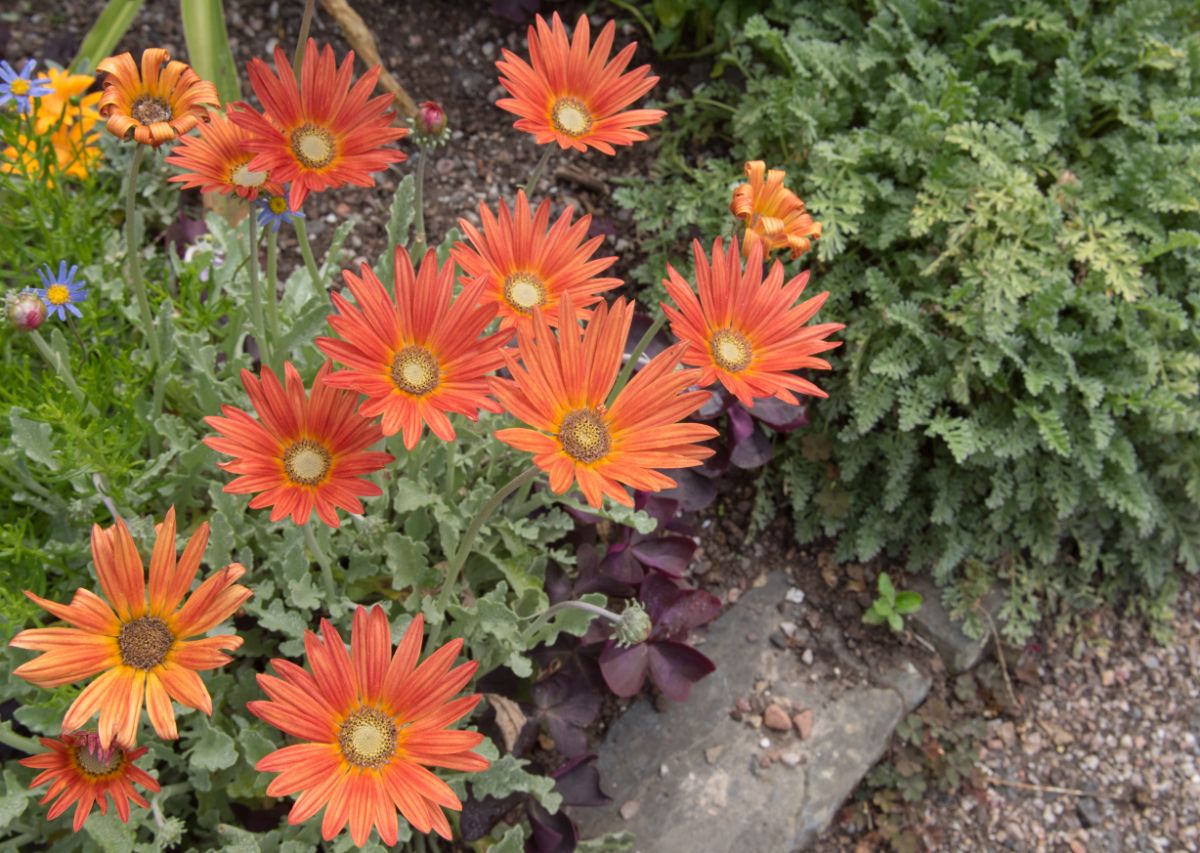
| Scientific name: | Arctotis × hybrida hort. 'Flame' |
| Plant Type: | Annual or Perennial |
| Sun Exposure: | Full sun |
| Watering Needs: | Occasional watering |
| Soil Type: | Chalky, loamy, or sandy well-drained soil |
| Hardiness Zone: | 9-11 (USDA) |
The ‘Flame’ African Daisy is a cultivar that produces showy orangish-red flowers and lobed grayish-green leaves. Its flowers grow on long stems with leaves that may be silver-colored underneath.
These eye-catching daisies show their bright colors from late spring until the first frost, though intense heat may cause them to temporarily stop blooming. Established plants require occasional watering during periods of intense heat or drought.
Florist's Daisy

| Scientific name: | Chrysanthemum × grandiflorum |
| Plant Type: | Annual |
| Sun Exposure: | Full to partial sun |
| Watering Needs: | Infrequent watering |
| Soil Type: | Well-drained soil |
| Hardiness Zone: | 7-9 (USDA) |
Chrysanthemum x grandiflorum, or Florist's Daisy, is an autumn-blooming perennial plant that many people use for containers, borders, or cut flowers in the fall. You can find Florist's Daisies in various sizes and colors, including yellow, orange, pink, red, orange, purple, lavender, and bronze.
This award-winning and showy flower should be planted in early spring in an area where they can get some shade from the afternoon sun. If they receive too little water, their stems will start to droop and lose their leaves, while too much water will cause yellowing of the leaves before they blacken and fall off.
Gaillardia Daisy
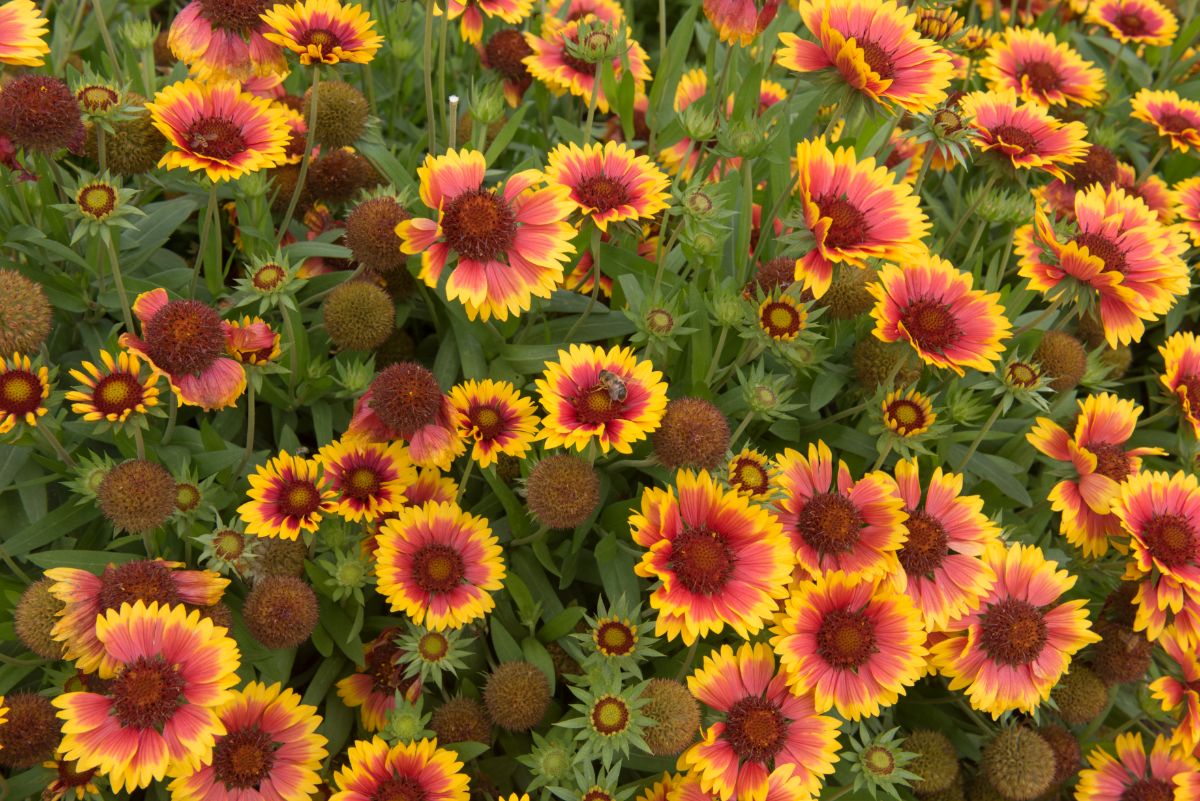
| Scientific name: | Gaillardia x Grandiflora |
| Plant Type: | Perennial |
| Sun Exposure: | Full sun |
| Watering Needs: | Infrequent to regular watering |
| Soil Type: | A poor, well-draining soil |
| Hardiness Zone: | 3-10 (USDA) |
Gaillardia, also known as blanket flower, is a vibrant daisy variety that anyone can easily grow. This plant forms a mound that continually spreads, hence its common name. As you may have guessed, these daisies are popular to use as a blanket plant that will spread about 20 inches and reach up to two feet in height.
They grow quickly and will bloom in the 2nd year when grown from seed. It comes in shades of red, orange, and yellow, sometimes with a sunset-like ombre.
Gerbera Daisy
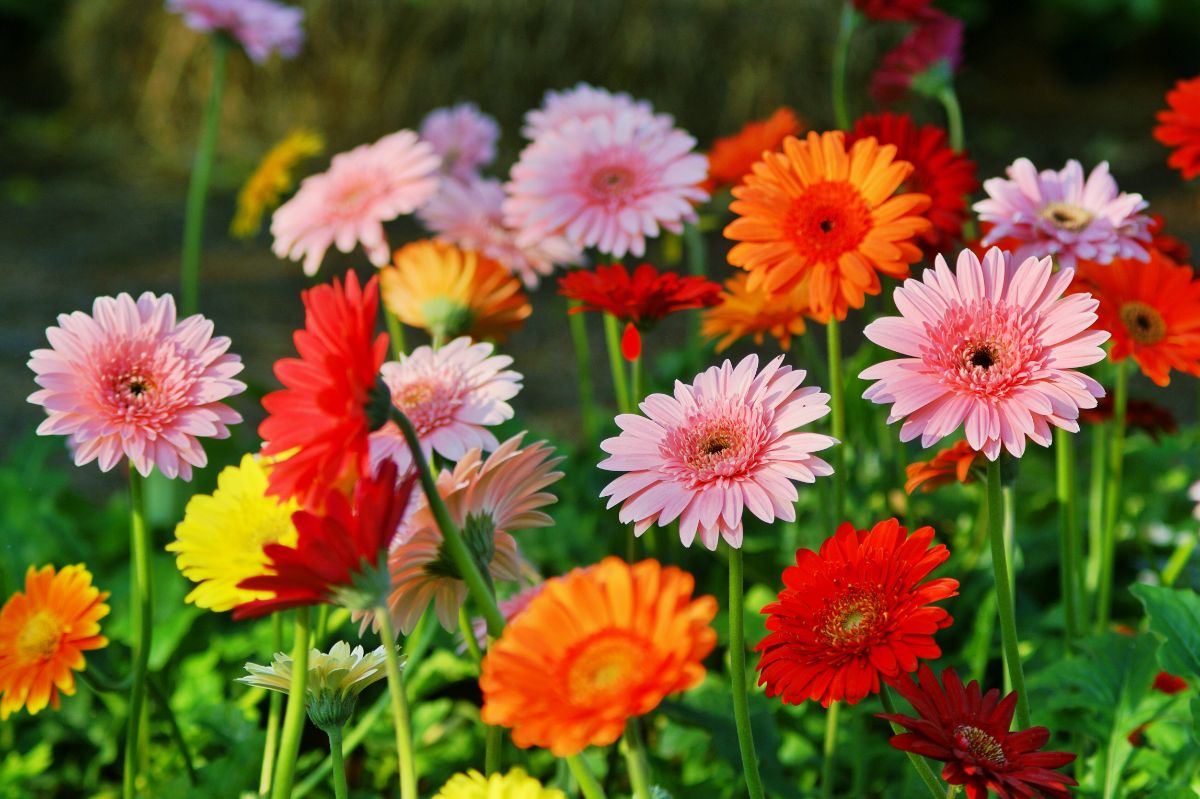
| Scientific name: | Gerbera jamesonii |
| Plant Type: | Herbaceous perennial |
| Sun Exposure: | Full sun to partial shade |
| Watering Needs: | Regular watering, about 1 inch per week |
| Soil Type: | Well-drained |
| Hardiness Zone: | 8-10 (USDA) |
Gerbera daisies come in saturated shades of white, yellow, orange, pink, salmon, lavender, or bicolored. Though you can typically find Gerbera daisies in containers, they are easy to grow from seed. However, they are slow developers, so seed growth is optimal for warmer climates where they can thrive year-round.
You can place them in full sun or a partially shaded area in your garden, so long as they have regular watering with well-drained soil.
Gloriosa Daisy
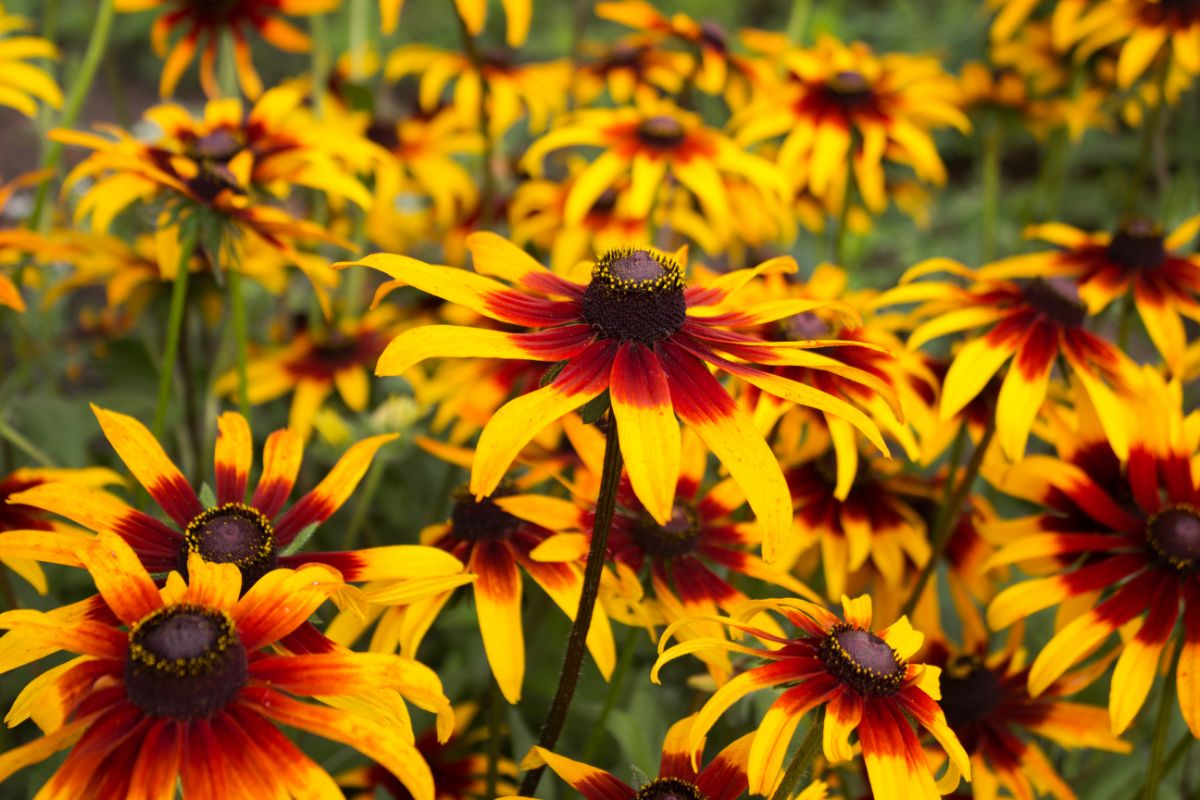
| Scientific name: | Rudbeckia hirta |
| Plant Type: | Herbaceous perennial |
| Sun Exposure: | Full sun |
| Watering Needs: | Water when soil is dry |
| Soil Type: | Moist to dry, well-drained |
| Hardiness Zone: | 3-7 (USDA) |
The Gloriosa Daisy, also known as Black-Eyed Susans, has become wildly popular as an annual in many gardens. They're fast-growing flowers that you may see along the sides of roads in the midwest. These self-seeding flowers make them a top choice for large wildflower gardens.
Though it may take a few years for them to reach their full height, they will show their pretty bright, red, or bronze blooms in their first summer. Black-Eyed-Susans are easily established plants and thrive on minimal maintenance, aside from deadheading faded flowers.
Golden Marguerite
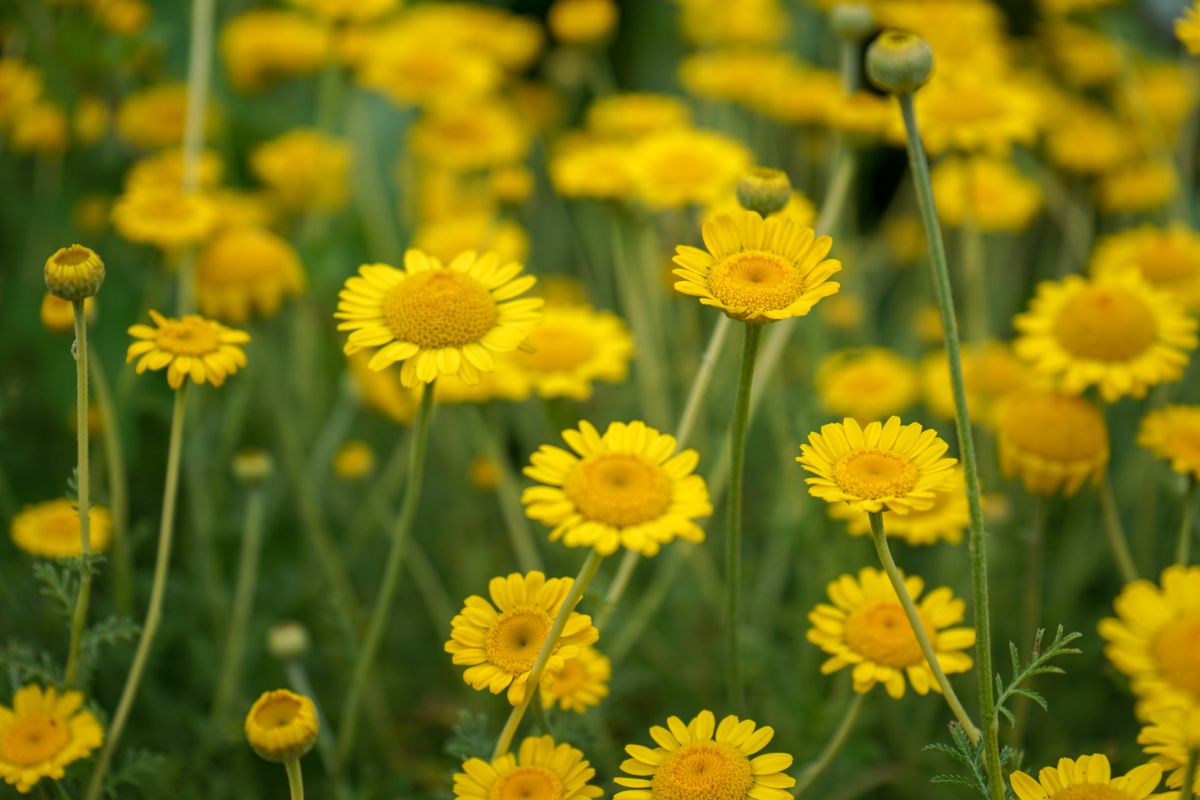
| Scientific name: | Anthemis tinctorial |
| Plant Type: | Perennial |
| Sun Exposure: | Full sun |
| Watering Needs: | Infrequent to regular watering |
| Soil Type: | Average to dry |
| Hardiness Zone: | 3-7 (USDA) |
The Golden Marguerite, also referred to as Yellow Chamomile, is an almost completely deep-yellow flower with its blooms and central disk. Its textured foliage has a soft scent that is similar to varieties of chamomile.
Golden Margurite flowers are popular bouquets or vase flowers with their long stems and distinctive color. One of the main benefits of Golden Marguerite is its ability to handle periods of drought. Even though it will survive a missed watering or two, they do best with regular watering after the soil dries out.
Indian Chrysanthemum Daisy
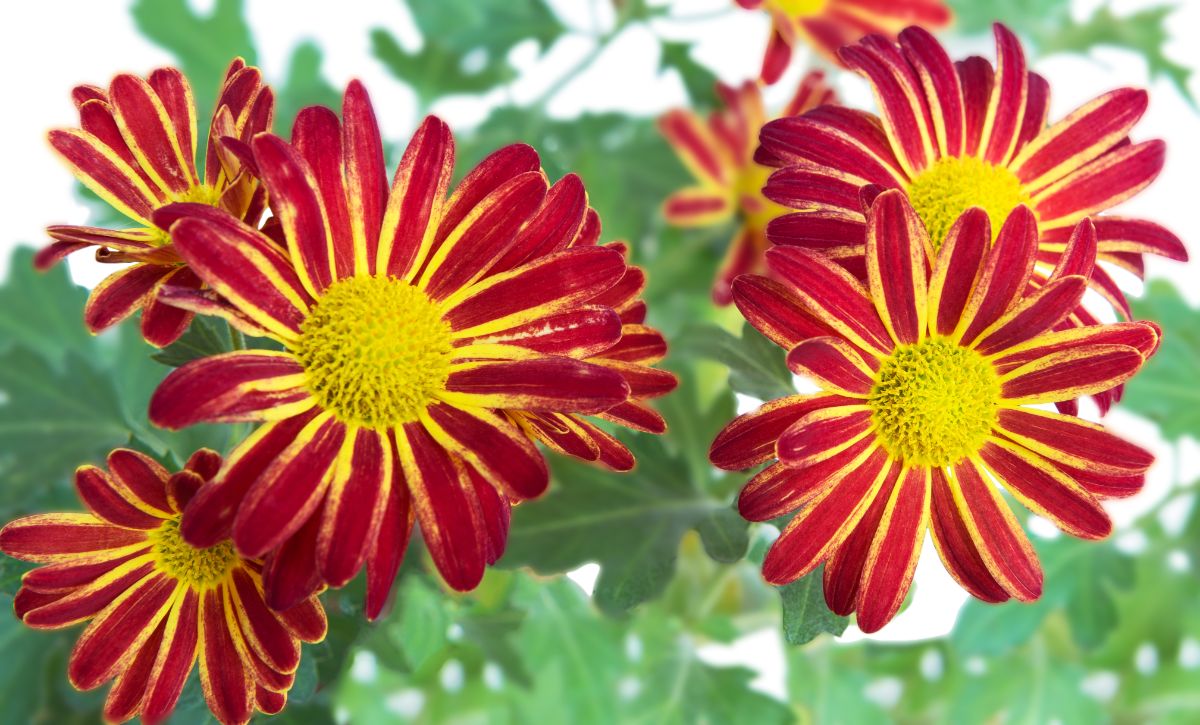
| Scientific name: | Chrysanthemum indicum |
| Plant Type: | Perennial |
| Sun Exposure: | Full sun |
| Watering Needs: | Regular watering |
| Soil Type: | Moist sandy, loamy, or clay soil |
| Hardiness Zone: | 5-9 (USDA) |
Indian Chrysanthemum Daisies can grow up to two feet tall and comes in various colors, including pink, red, orange, and yellow. Its deep green foliage is commonly used to make healing teas that boast benefits, including reduced risk of heart disease, stroke, arthritis, and high blood pressure.
These flowers prefer regular, even watering in moist soil. Once the ground freezes, you can stop watering until spring.
Livingstone Daisy
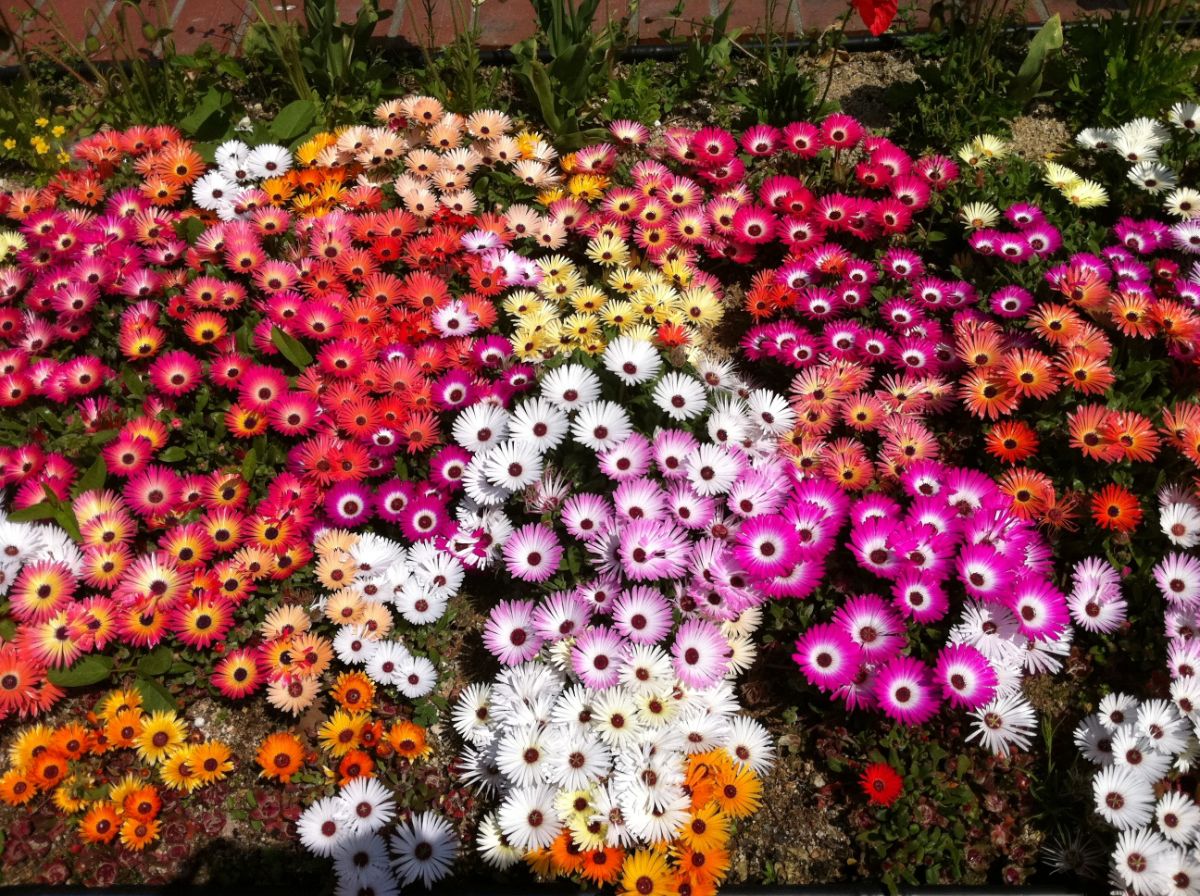
| Scientific name: | Dorotheanthus bellidiformis |
| Plant Type: | Annual |
| Sun Exposure: | Full sun |
| Watering Needs: | Allow soil to dry between waterings |
| Soil Type: | Gritty, sharply drained soil |
| Hardiness Zone: | 11-12 (USDA) |
Native to South Africa, the Livingstone Daisy is a low-height plant that branches out like a carpet of flowers. Its pastel flower blooms may be shades of pink, purple, white, lavender, crimson, or orange and all have a dark center.
These annuals prefer gritty soil with good drainage, and you only need to water them once the soil has dried.
Marguerite Daisy
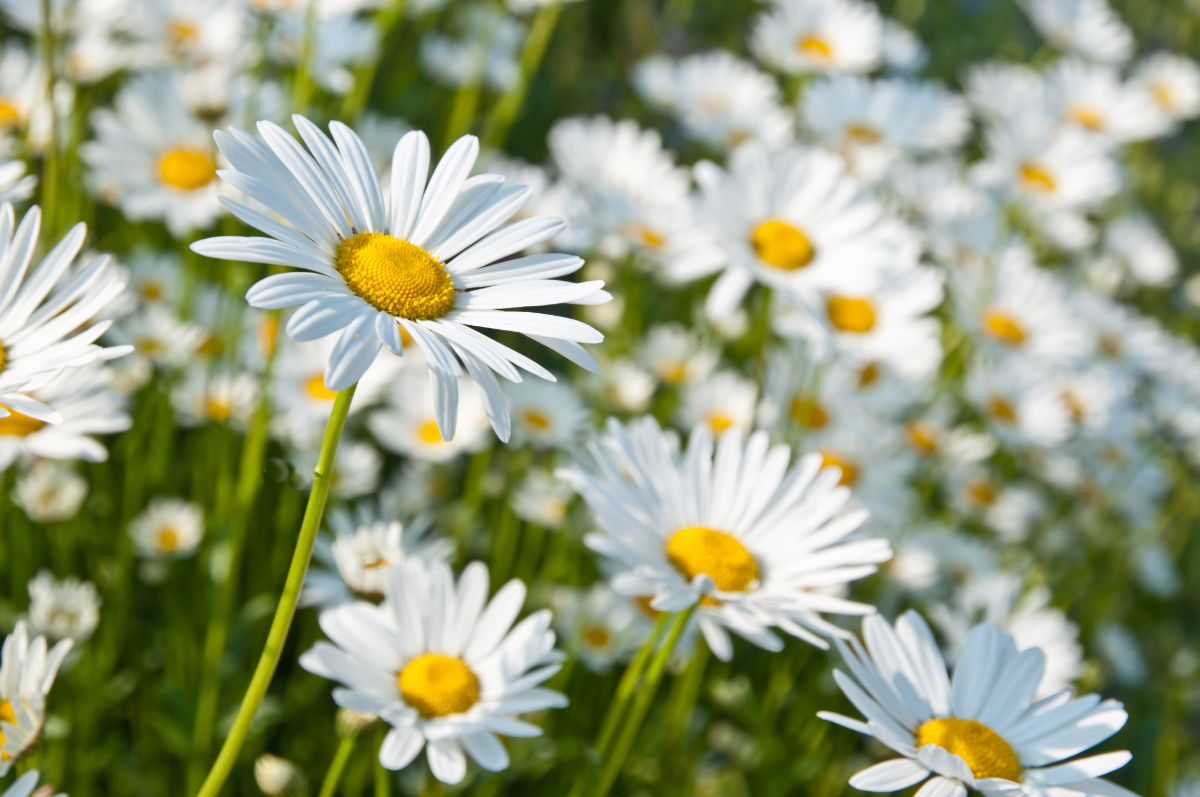
| Scientific name: | Argyranthemum frutescens |
| Plant Type: | Annual |
| Sun Exposure: | Full sun |
| Watering Needs: | Regular weekly watering |
| Soil Type: | Well-drained |
| Hardiness Zone: | 8-11 (grown as an annual elsewhere) |
Marguerite, also meaning “daisy” in French, is an annual plant that grows best in a sunny area with regular watering. Also referred to as the Cobbitty Daisy, their brightly colored pink or yellow flowers give you repeated blooms all season, depending on which hardiness zone you grow them in.
There are roughly 23 known species of Marguerite, though others have continued to be introduced worldwide.
Nippon Daisy
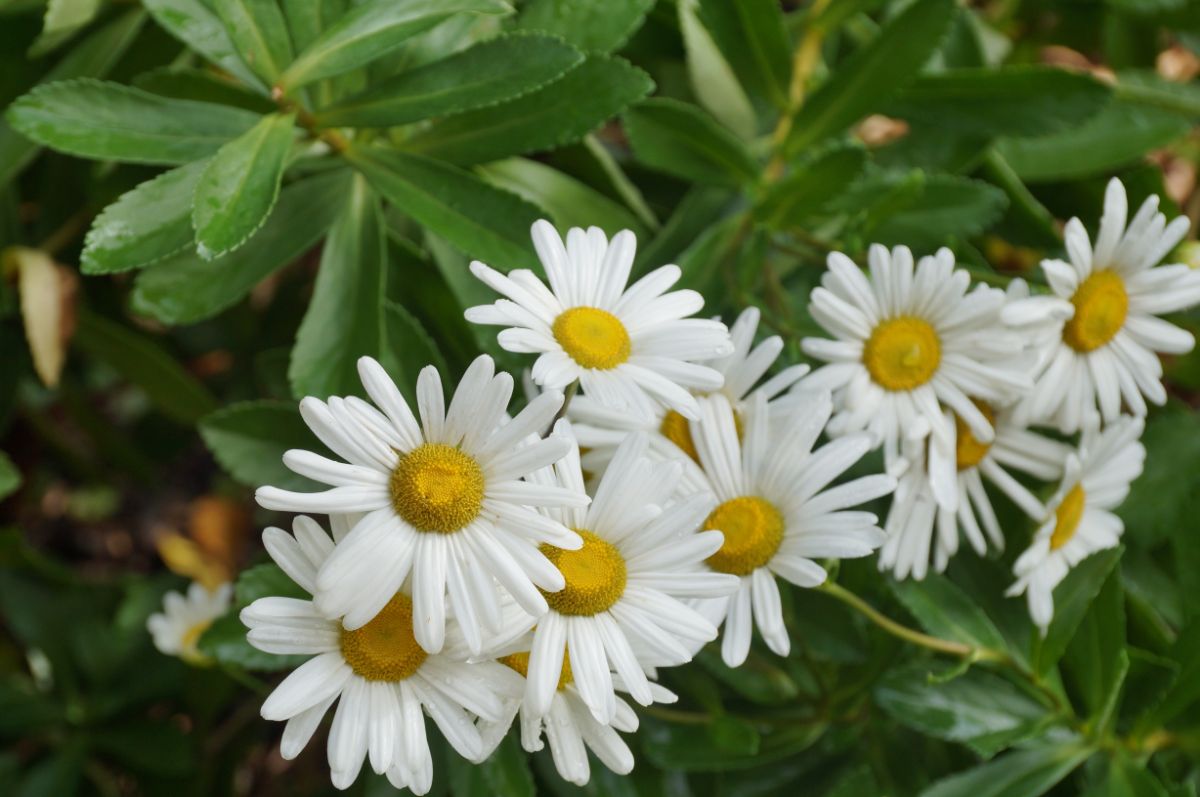
| Scientific name: | Nipponanthemum nipponicum |
| Plant Type: | Herbaceous Perennial |
| Sun Exposure: | Full sun |
| Watering Needs: | Regular watering, avoid overwatering |
| Soil Type: | Average, dry, well-draining |
| Hardiness Zone: | 5-9 (USDA) |
The Nippon Daisy, also known as the Montauk Daisy, is a herbaceous perennial that blooms throughout the summer until the first frost. They may reach up to three feet tall and typically reaches their full size within a couple of months.
Because of their long stems, shiny green leaves, and white petals with bright yellow centers, they are popular as cut flowers. Nippon daisies require minimal maintenance once established, though some spring pruning will keep them looking their best.
Oxeye Daisy
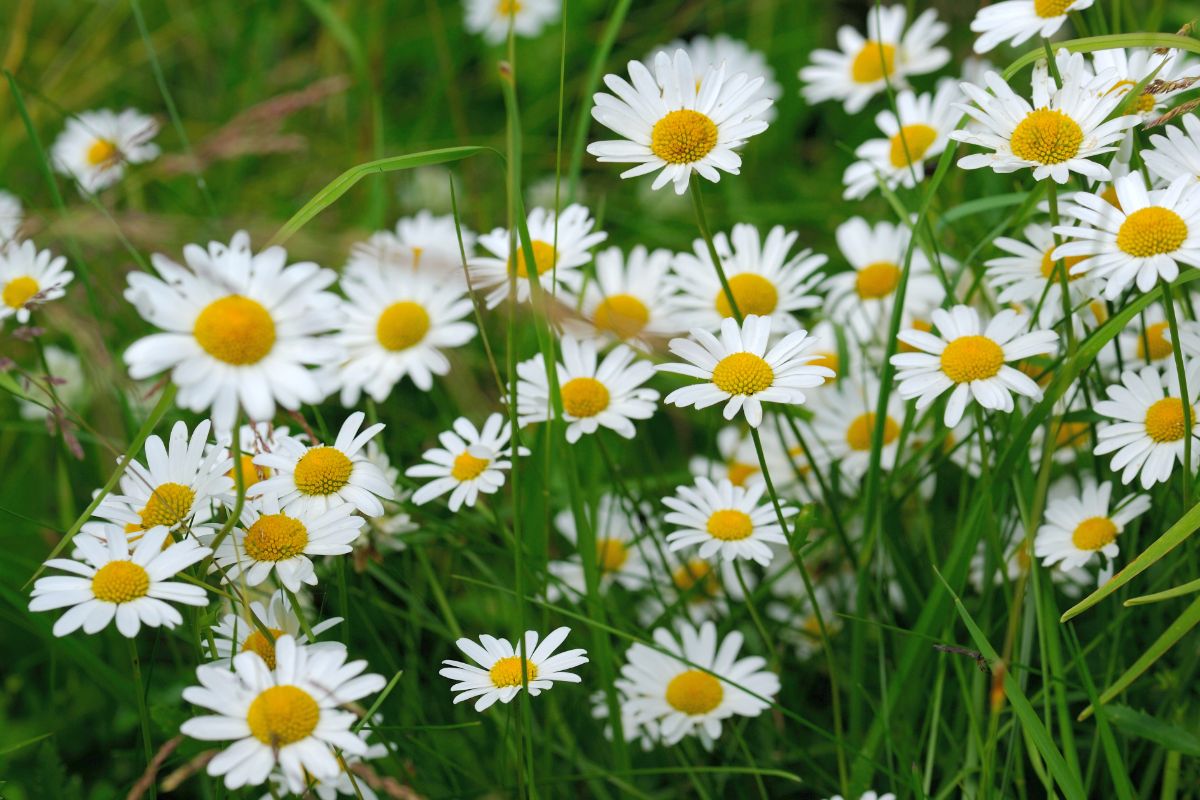
| Scientific name: | Leucanthemum vulgare |
| Plant Type: | Perennial wildflower |
| Sun Exposure: | Full sun to partial shade |
| Watering Needs: | Only water when soil is dry |
| Soil Type: | Well-drained |
| Hardiness Zone: | 3-8 (USDA) |
As the name suggests, Oxeye daisies are perennial wildflowers with the Old English meaning 'day's eye', giving reference to its flowers closing at night and opening the next morning.
They have a stereotypical daisy appearance with bright white petals surrounding a yellow center disk, though their flowers are only one to three inches across.
These flowers are easy to grow whether or not they are grown from seed. These self-seeding flowers can spread rapidly, are classified as invasive in some areas, and is on the Washington State quarantine list.
Painted Daisy
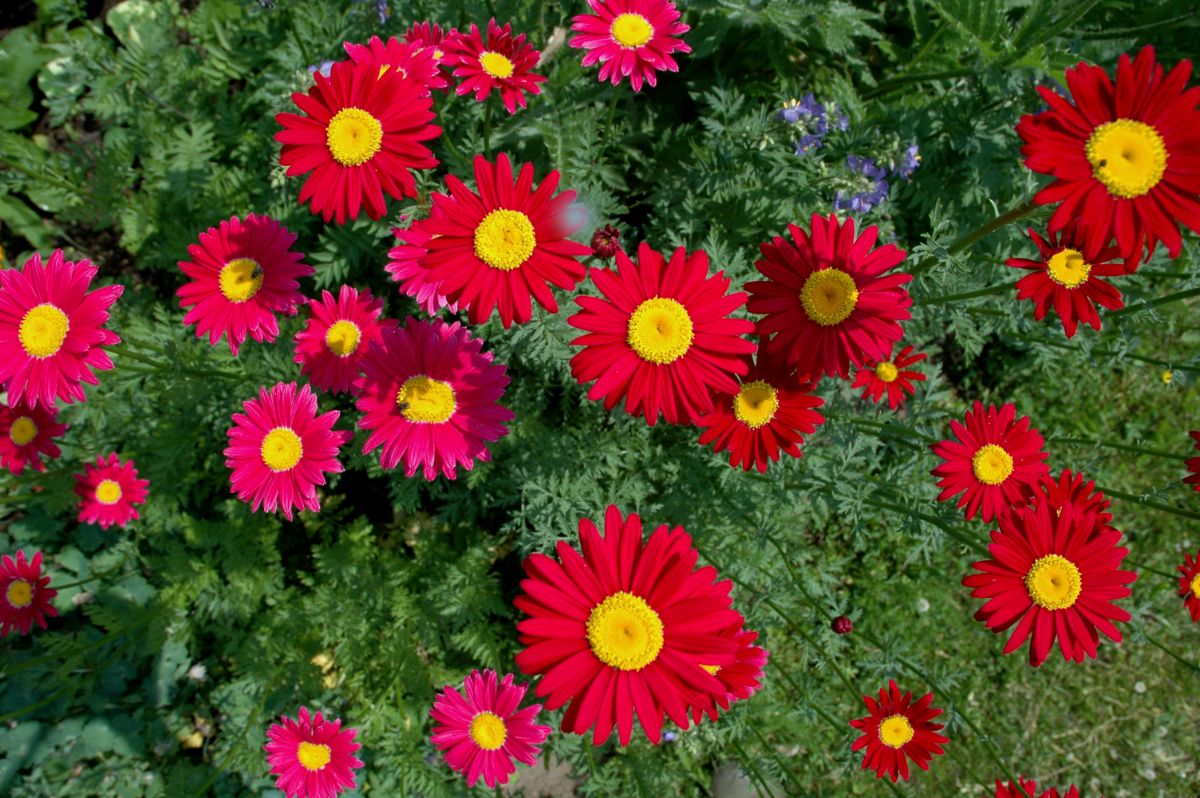
| Scientific name: | Tanacetum coccineum |
| Plant Type: | Herbaceous perennial |
| Sun Exposure: | Full to partial shade |
| Watering Needs: | Regular watering |
| Soil Type: | Acidic, neutral, alkaline |
| Hardiness Zone: | 3-7 |
Painted Daisies are flowers that anyone can grow to enjoy their vivid blooms. Its foliage is fern-like, and blooms come in shades of pink, red, yellow, white, and violet surrounding a golden-yellow center.
They like moderate, regular watering but can withstand periods of drought. During hot weather, give Painted Daisies plenty of watering to make the soil moist, but don't overwater.
PowWow® Wild Berry Coneflower Daisy
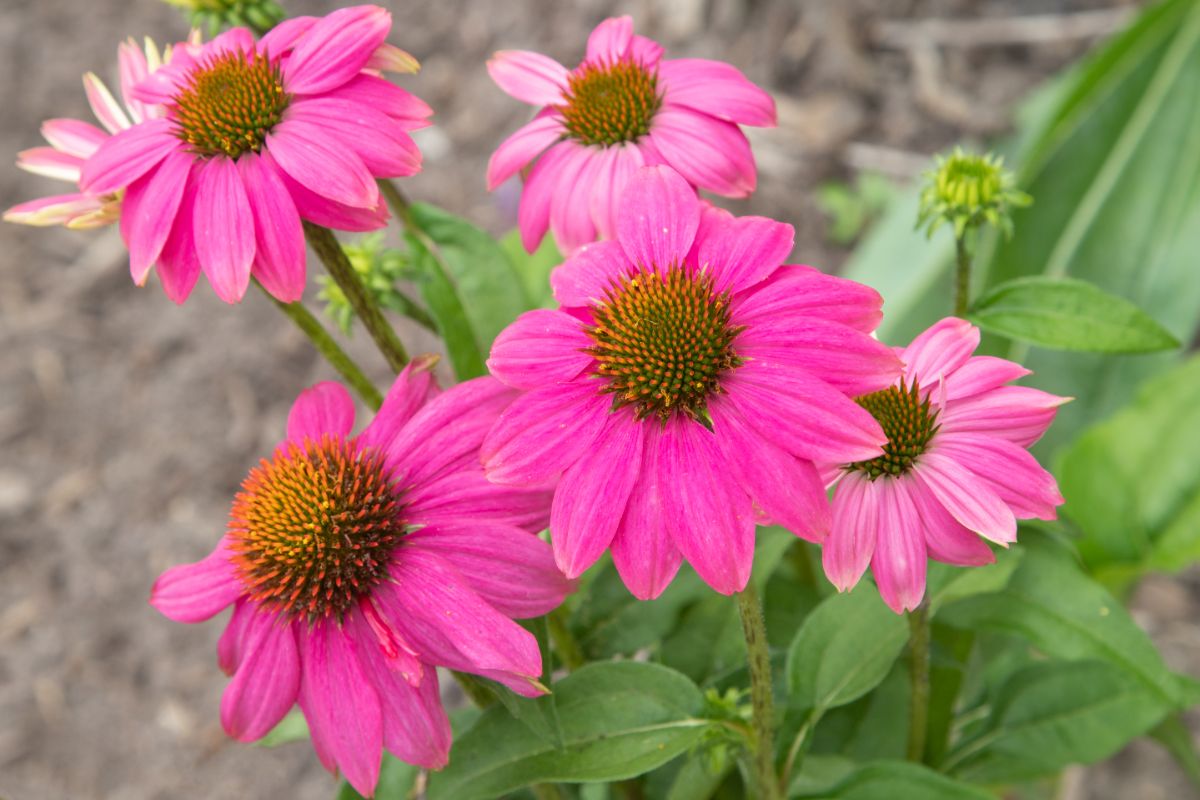
| Scientific name: | Echinacea purpurea PowWow |
| Plant Type: | Perennial |
| Sun Exposure: | Full sun to partial shade |
| Watering Needs: | Light watering |
| Soil Type: | Dry to medium well-drained soil |
| Hardiness Zone: | 4–9 (USDA) |
PowWow® Wild Berry is a variety of Purple Coneflower that was bred to create its distinctive dark purplish-red flowers. These unique daisies are compact plants and prefer slightly cooler climates.
In most areas, they will bloom in the summer with large, showy flowers that may reach up to five inches in diameter. Once they're established, they need occasional watering during periods of hot weather.
Pure White Butterfly® Marguerite
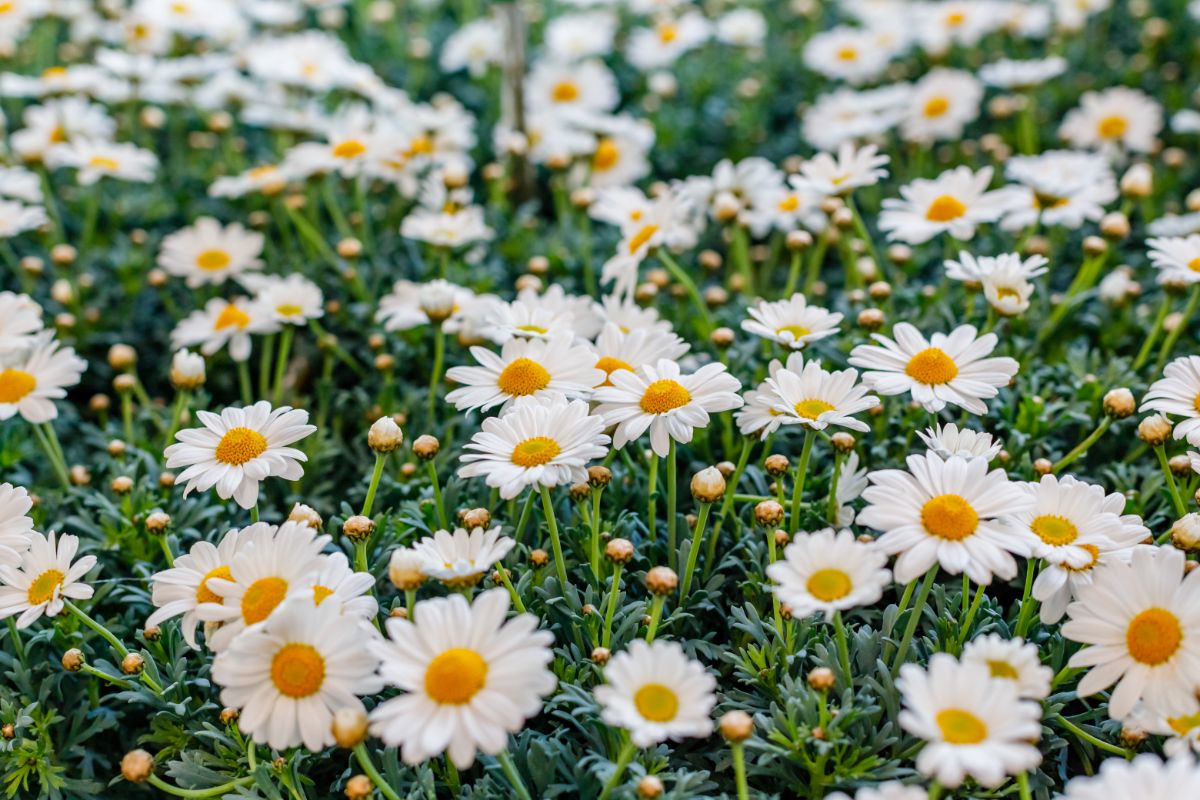
| Scientific name: | Argyranthemum frutescens |
| Plant Type: | Annual |
| Sun Exposure: | Part sun to full sun |
| Watering Needs: | Water when the first inch of soil is dry to the touch |
| Soil Type: | Average soil |
| Hardiness Zone: | 10-11 (USDA) |
For a bright white and large flower head, you can't go wrong with the Butterfly Marguerite Daisy. These flowers don't require deadheading like many daisies. They are more tolerant to hot temperatures than other Marguerite varieties, though they prefer areas with cooler summer nights.
To enjoy its stunning blooms, plant Butterfly Marguerite Daisies in an area that gets partial to full sunlight. You only need to water these daisies once the soil is dry to the touch and give them fertilizer regularly.
Revolution™ Bicolor Red Lemon Gerbera Daisy
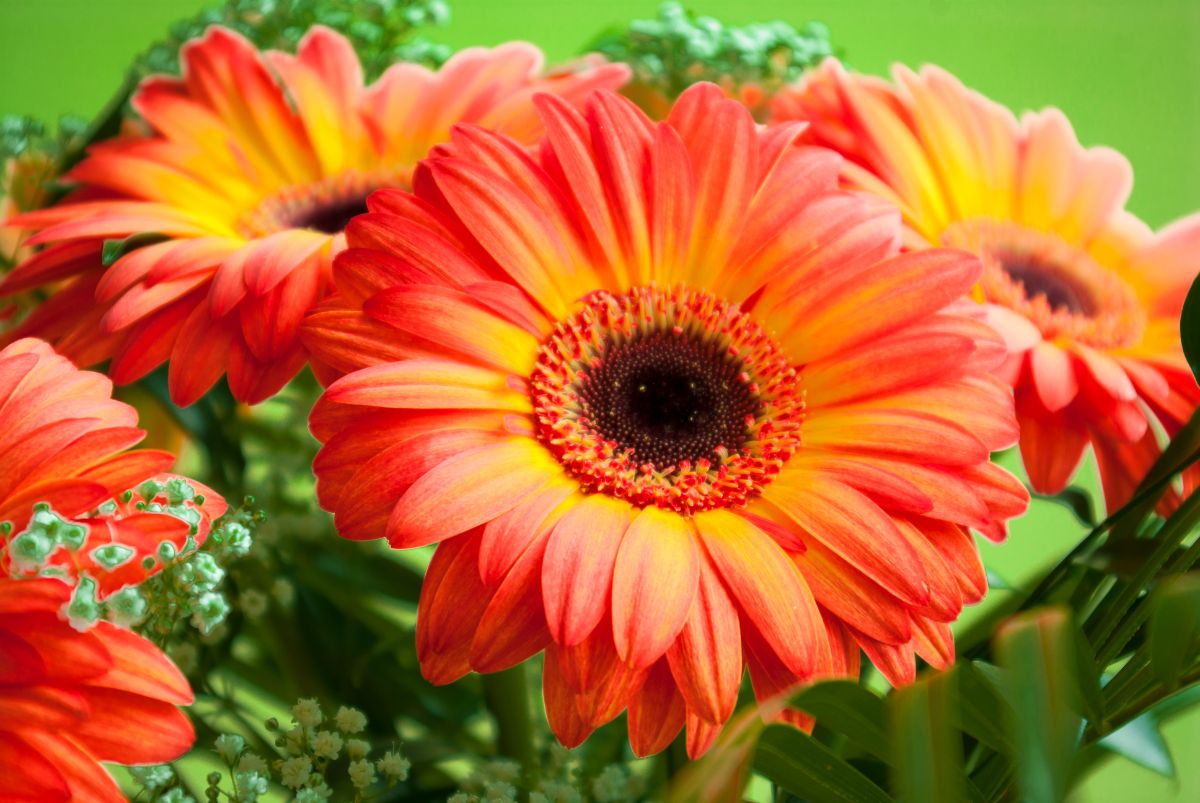
| Scientific name: | Gerbera jamesonii |
| Plant Type: | Perennial |
| Sun Exposure: | Partial sun |
| Watering Needs: | Water deeply and let the soil become nearly dry before watering again |
| Soil Type: | Moist and well-drained |
| Hardiness Zone: | 8-10 |
Often referred to as the African Daisy, Revolution™ Bicolor Red Lemon Gerbera Daisy offers blooms that fade from orange or yellow to red like a bright sunset.
These distinctive blooms do best when watered deeply before letting them dry out in rich, well-drained soil. Though they thrive in full sun, they enjoy a little shade during hot afternoons.
Shasta Daisy

| Scientific name: | Leucanthemum × superbum |
| Plant Type: | Perennial |
| Sun Exposure: | Full sun to partial shade |
| Watering Needs: | Regular watering, avoid overwatering |
| Soil Type: | Loamy, moist but well-drained |
| Hardiness Zone: | 5-9 (USDA) |
The Shasta Daisy gets its name from the snowy peaks of Mount Shasta. This hybrid perennial was developed in 1902 by Luther Burbank, who went on to continue developing hybrids. Crossed with an Oxeye Daisy and other varieties, these cheerful flowers are classic white with a yellow center eye.
You can find single and double varieties, all of which have dark, leathery green foliage. Butterflies and other pollinators love these flowers, but they are toxic to dogs and cats.
Silver Townsendia Daisy
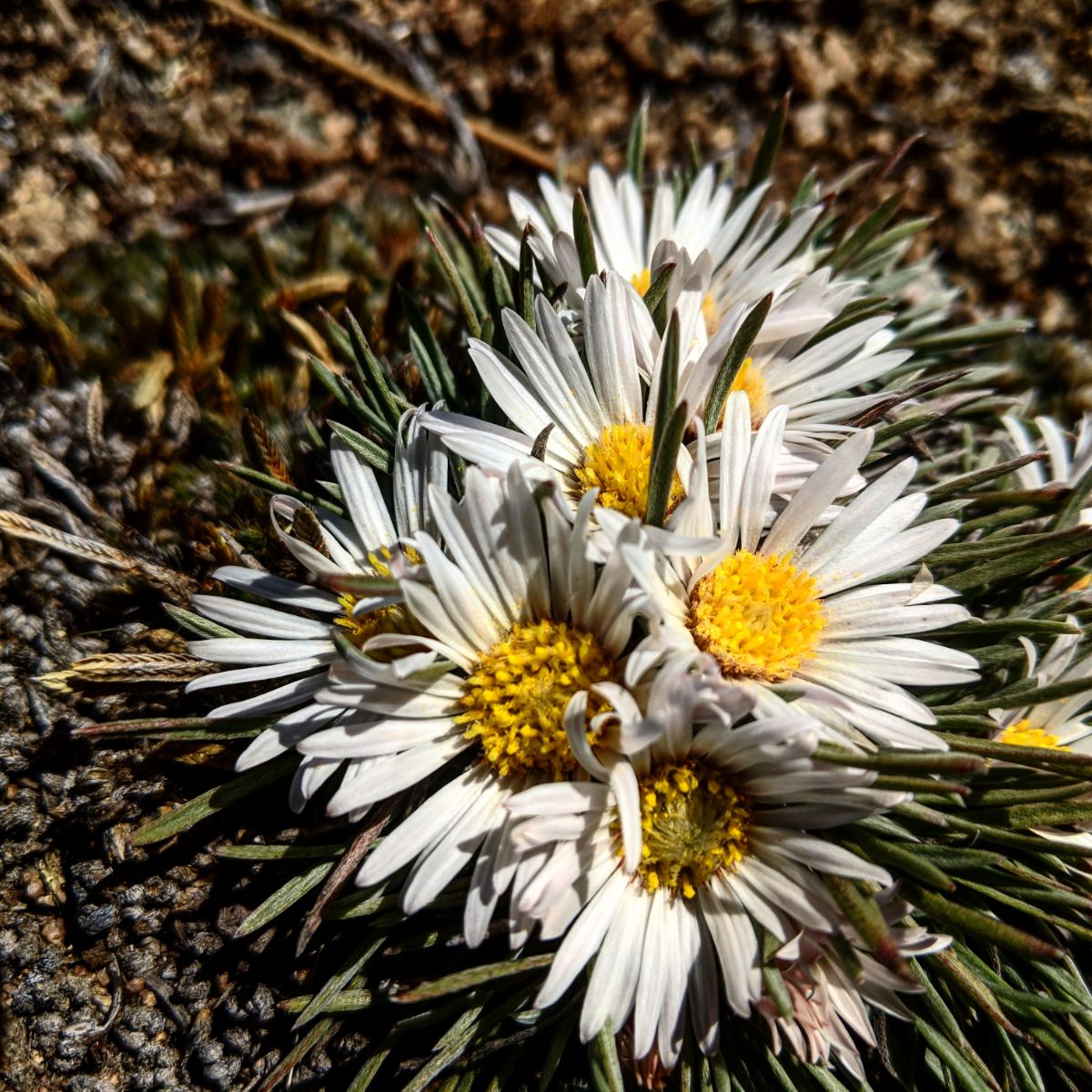
| Scientific name: | Townsendia incana |
| Plant Type: | Perennial |
| Sun Exposure: | Full sun |
| Watering Needs: | Moderate watering |
| Soil Type: | Sandy soils |
| Hardiness Zone: | 3-9 (USDA) |
Also known as Michaelmas Daisy or Easter Daisy, the Silver Townsendia Daisy is one of 27 Townsendia species, which are popular for their long stems for cut flowers.
Its long stems are covered in little white hairs, causing it to have a silvery appearance. Townsendia Daisies tend to flower near the leaves, making them look dense and full.
‘Sombrero Adobe Orange’ Coneflower Daisy
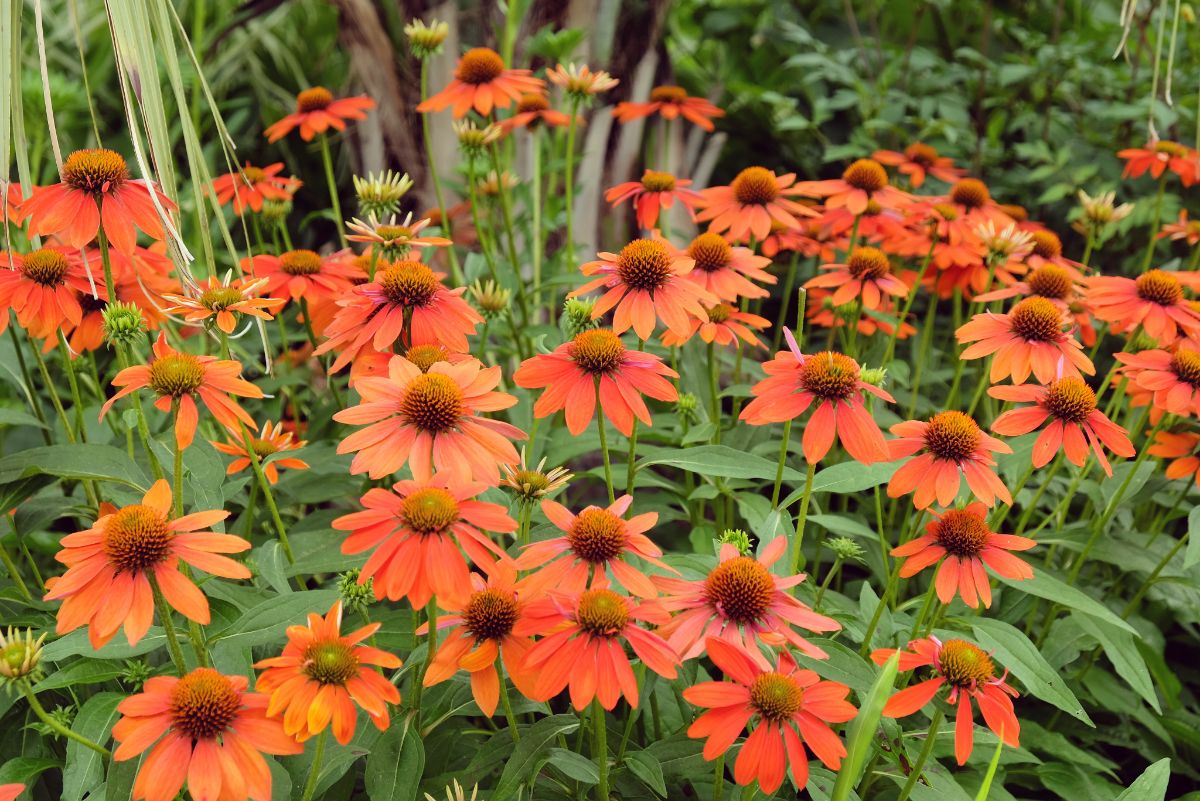
| Scientific name: | Echinacea ‘Sombrero Adobe Orange’ |
| Plant Type: | Perennial |
| Sun Exposure: | Full sun |
| Watering Needs: | Regular |
| Soil Type: | Average, Dry, Moist, Rich |
| Hardiness Zone: | 4-9 (USDA) |
‘Sombrero Adobe Orange’ Coneflower produces stunning pumpkin-colored orange blooms that attract butterflies and birds.
Just about any gardener can grow this Coneflower variety because of its ability to tolerate poor soil and drought, though it enjoys some water during a dry spell. Deadheading the flowers promote more of their brilliant blooming.
Swan River Daisy
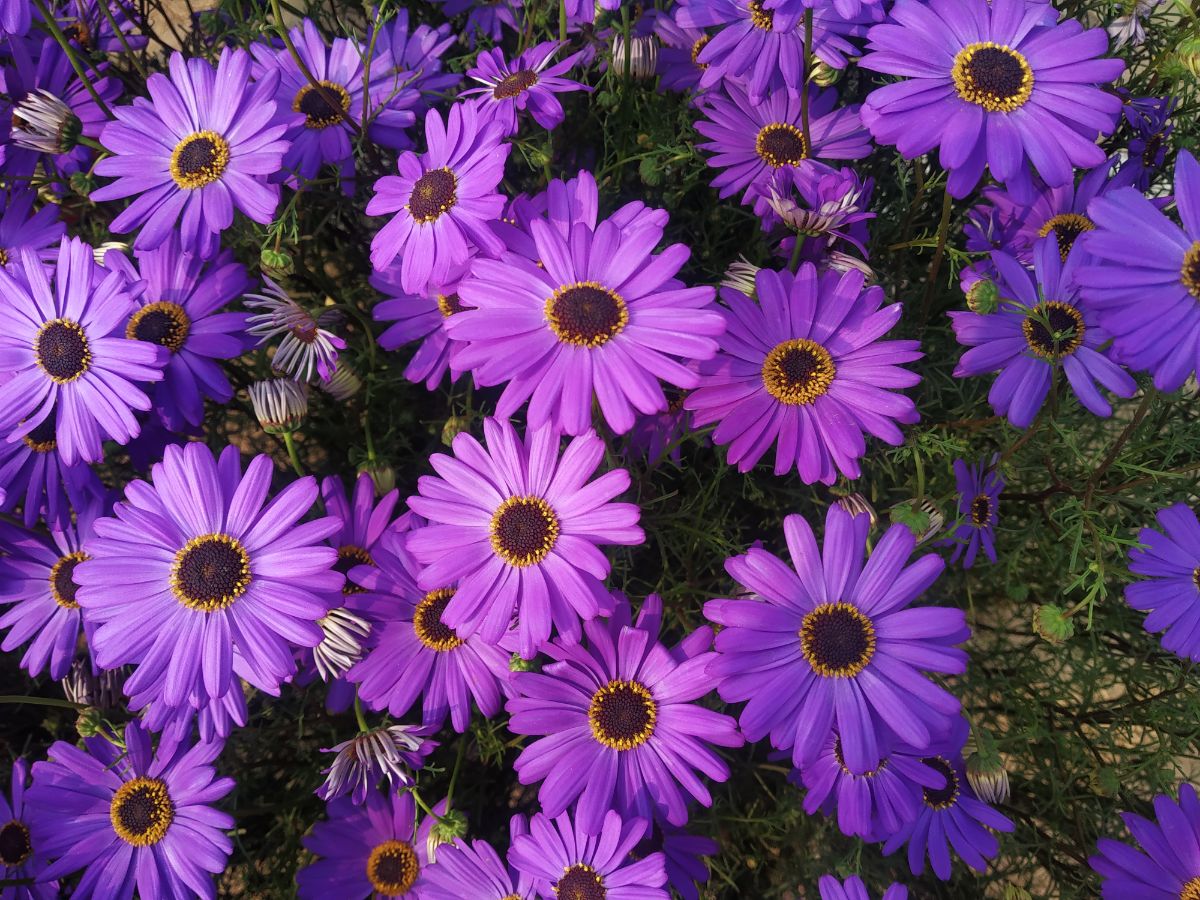
| Scientific name: | Brachyscome iberidifolia |
| Plant Type: | Annual or perennial |
| Sun Exposure: | Full sun |
| Watering Needs: | Light watering |
| Soil Type: | Rich, well-drained |
| Hardiness Zone: | 2-8 (annual), 9-11 (perennial) |
Though the Swan River Daisy is an Australian native, you can find colorful blooms across North America. You can find this stunning daisy in shades of blue, lavender, pink, yellow, or white with a yellow or dark center.
As these daisies grow, they form a mound with fine foliage and large stocks reaching up to a foot and a half tall. Don't let their tiny inch-width blooms deter you, however; you will get an abundance of bright flowers. These drought-tolerant beauties prefer time to let the soil dry out in between watering.
Wine African Daisy
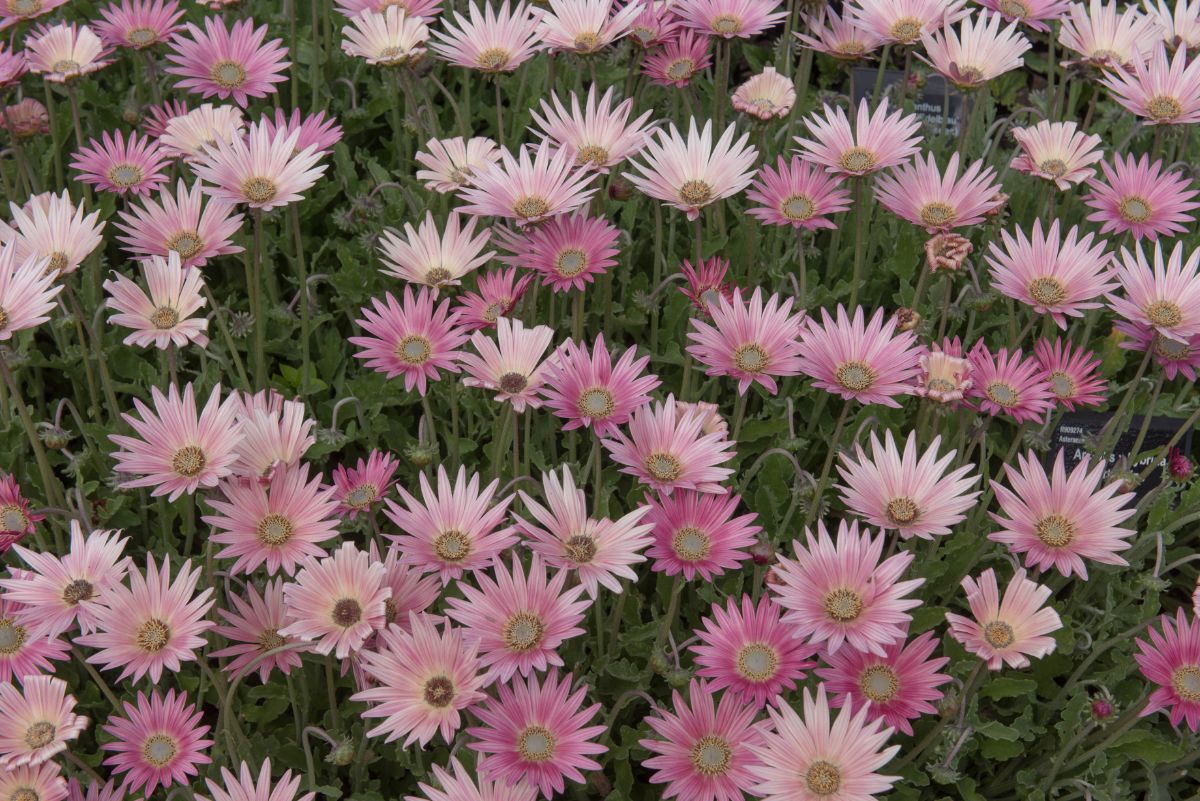
| Scientific name: | Arctotis x hybrida 'Wine' |
| Plant Type: | Annual or perennial |
| Sun Exposure: | Full sun |
| Watering Needs: | Occasional watering |
| Soil Type: | Well-drained soil |
| Hardiness Zone: | 9-11 (USDA) |
The ‘Wine’ African Daisy is a hybrid that may have simple or lobed leaves, which have a silver underside. Its light but deep pink showy flowers contrast beautifully against its silvery foliage in the summer through autumn.
As with many daisy varieties, the ‘Wine’ African Daisy is drought tolerant but enjoys watering during dry spells.
Frequently Asked Questions
Here are some of the most frequently asked questions about daisy varieties anyone can grow.
Shasta daisies are a popular daisy variety that anyone can grow because they can thrive in most garden conditions. These hardy daisies prefer moist and well-drained soil, though they do not necessarily require it. Shastas are famous for their easy-to-care-for nature and bloom power.
The six most popular daisy types are Shasta Daisies, Coneflowers, Gerbera Daisies, African Daisies, Marguerites, and Gloriosa Daisies.
Most daisies will have better blooms and new growth after deadheading. By deadheading regularly, you can enjoy their stunning blooms for longer.

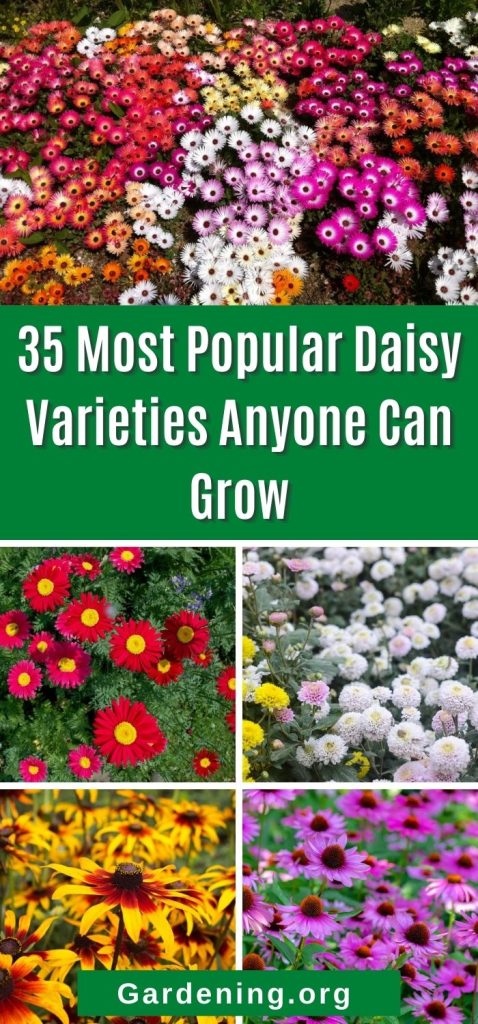
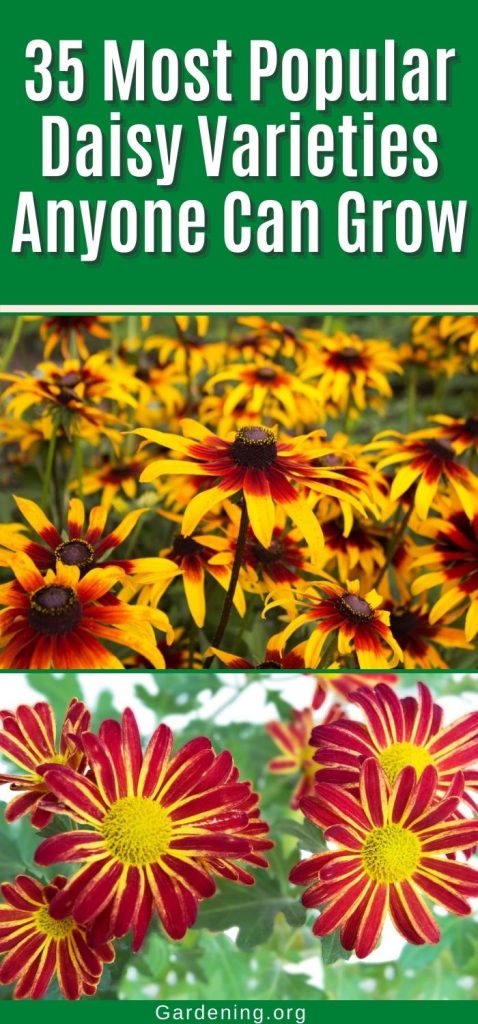
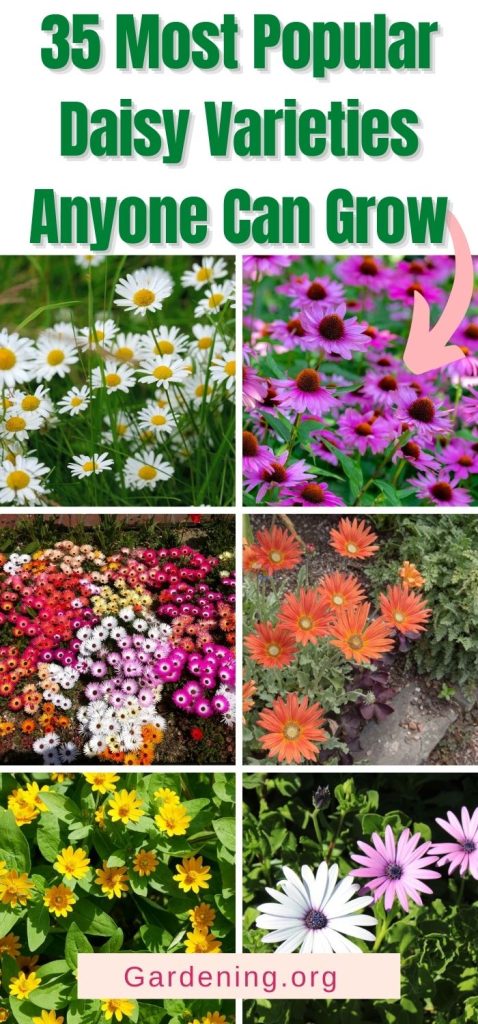


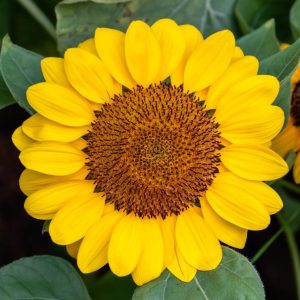
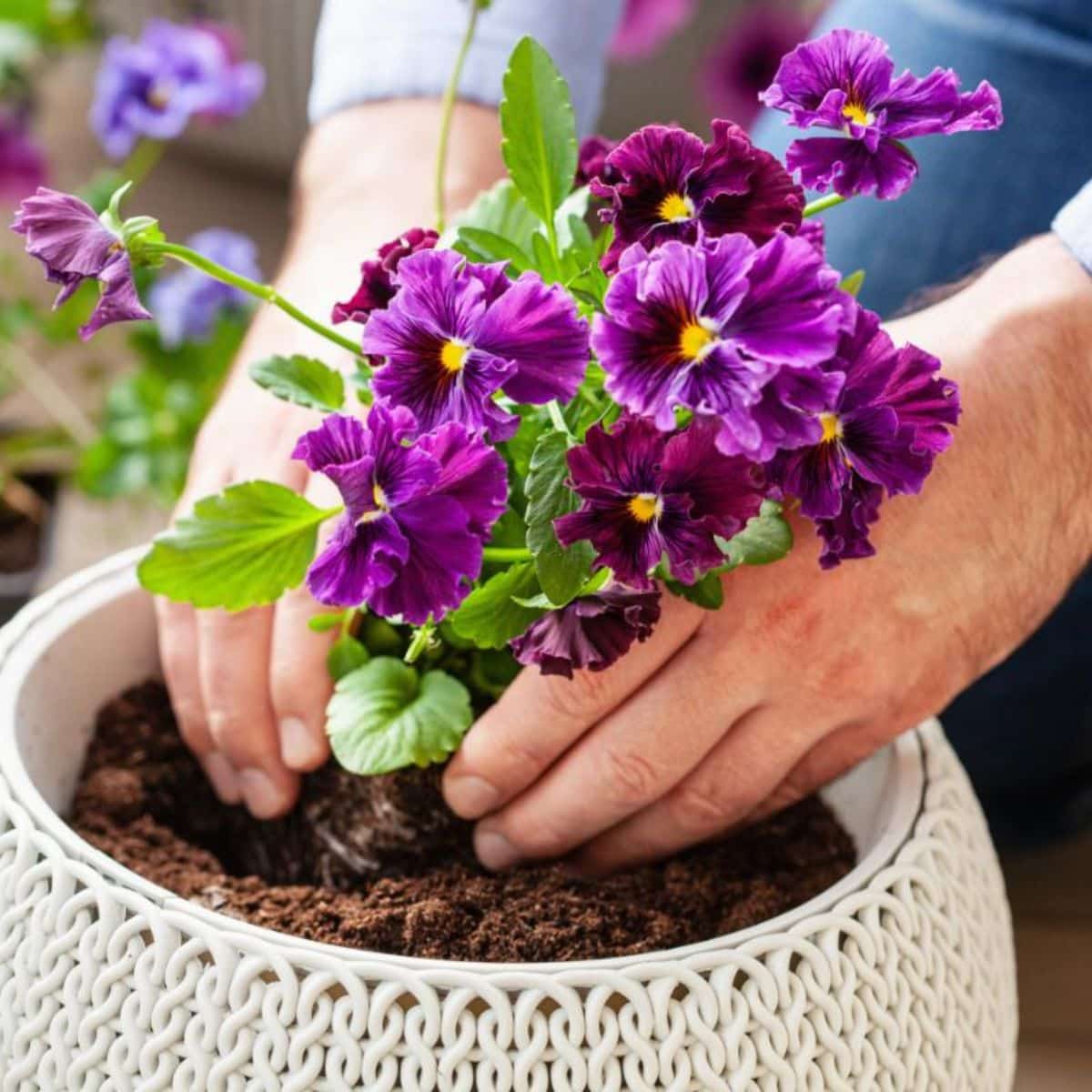
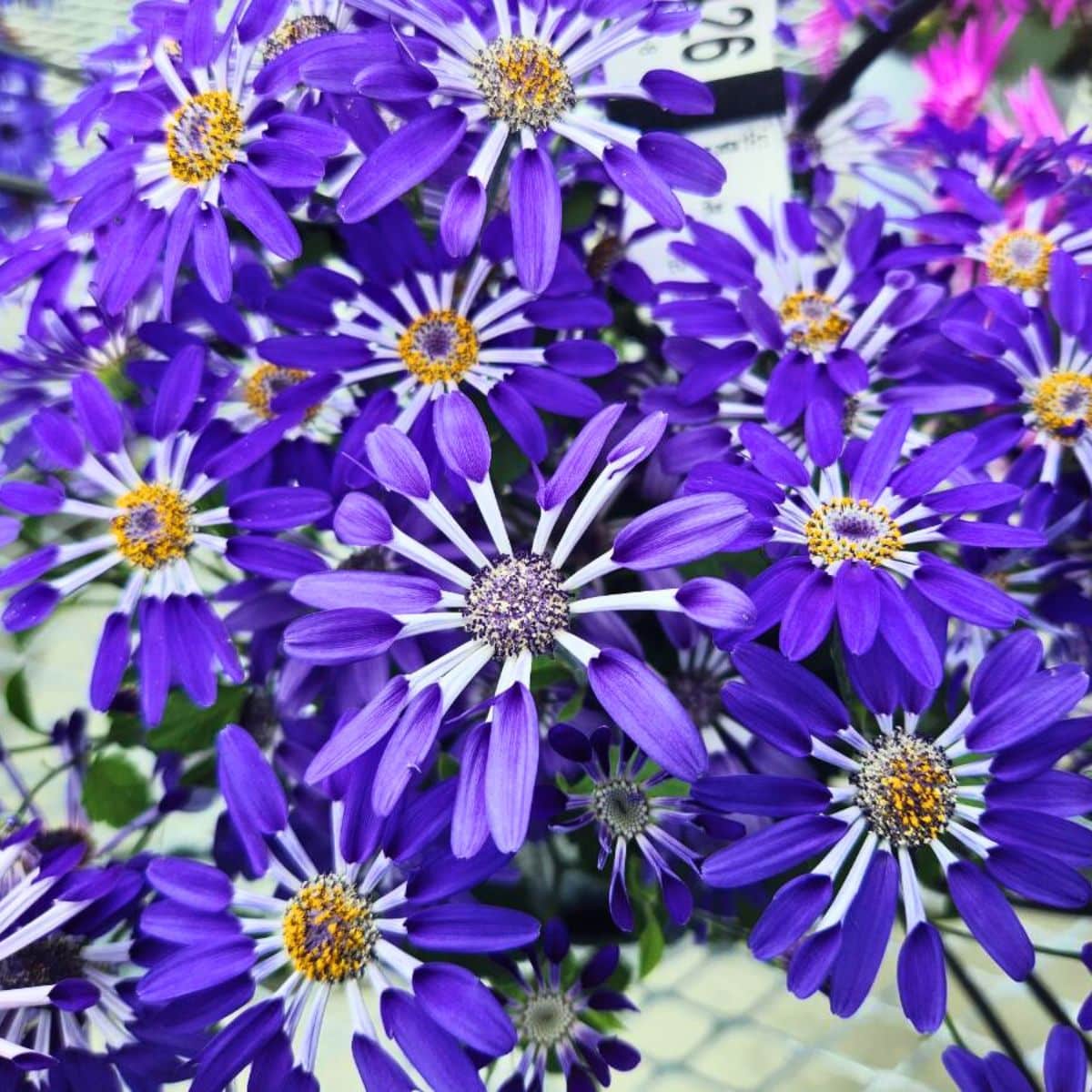
Frieda Howell
How can I order Shasta daisies?